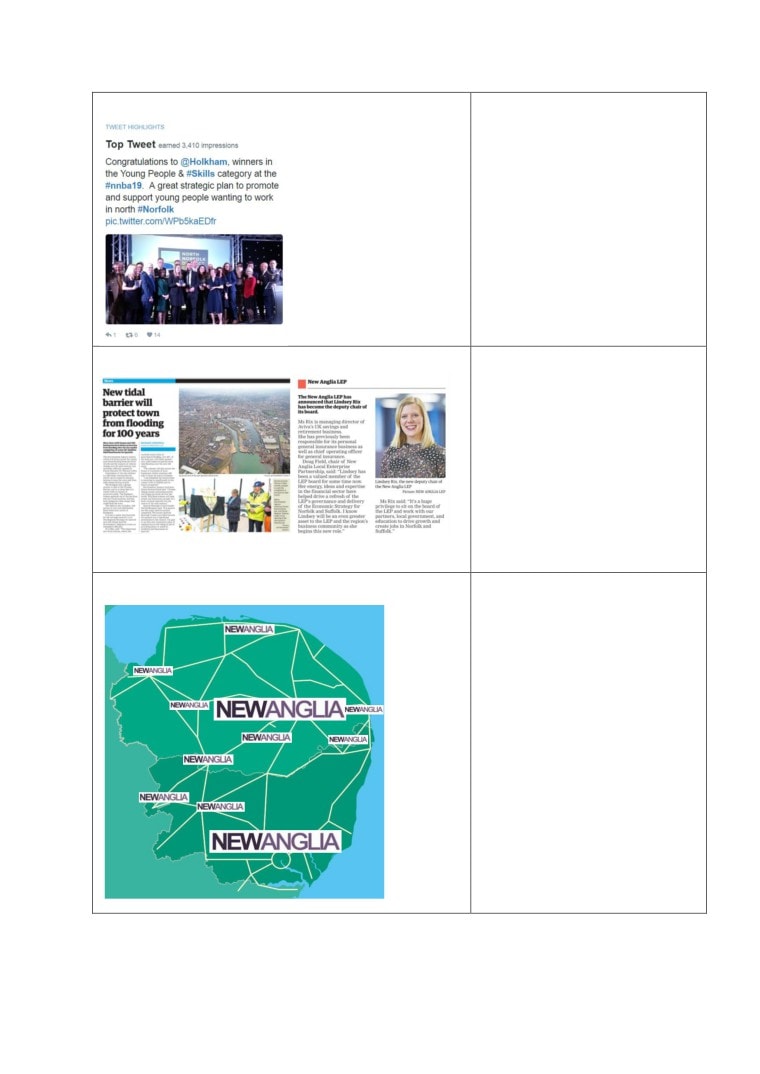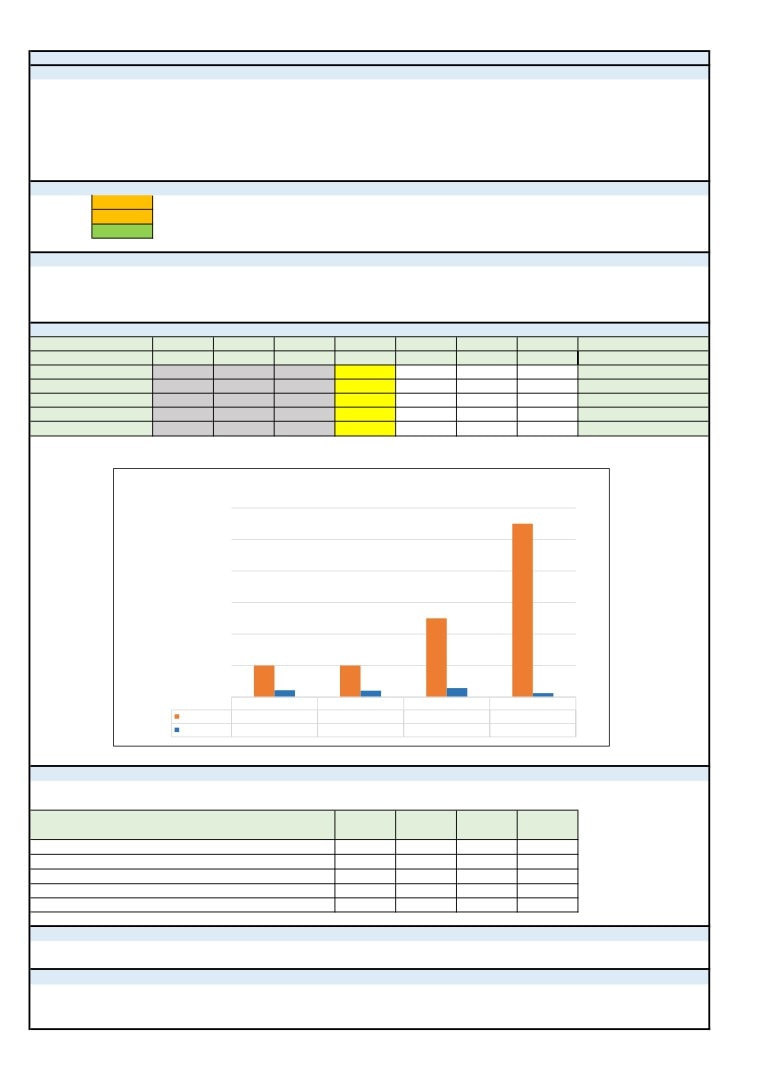New Anglia Local Enterprise Partnership Board Meeting
Wednesday 27th March 2019
10.00am to 12.30pm
Birketts Solicitors, Providence House, 141-145 Princes Street
Ipswich IP1 1QJ
Agenda
No.
Item
Duration
20 mins
1.
Welcome from the Chair
2.
Apologies
3
Welcome from Jonathan Agar, Birketts CEO
4.
Declarations of Interest
5
Actions / Minutes from the last meeting
Governance and Delivery
50 mins
6.
Delivery Plan
For Approval
7
2019/2020 Budget
For Approval
8.
Brexit
Update
9.
Capital Growth Programme Call
For Approval
Break
10 mins
Governance and Delivery
70 mins
10.
New Anglia LEP Governance
For Approval
11.
European Structural and Investment Funds Strategy
For Approval
12.
Amendments to Articles of Association
For Approval
13.
Chief Executive’s Report
Update
14.
March Programme Performance Reports including a confidential report
Update
15.
Growth Deal Project Change Request
For Approval
16.
Finance Report including Confidential Appendix
Update
17.
Board Forward Plan
Update
18.
Any Other Business
Board Members Only
19.
Remuneration Committee Update
Update
Next Meeting: 10.00am - 12.30pm, 23rd May 2019
Venue: TBC
1
New Anglia Board Meeting Minutes (Unconfirmed)
27th February 2019
Present:
David Ellesmere (DE)
Ipswich Borough Council
Doug Field (DF)
East of England Coop
Matthew Hicks (MH)
Suffolk County Council
Steve Oliver (SO)
MLM Group
Andrew Proctor (AP)
Norfolk County Council
Johnathan Reynolds (JR)
Nautilus
David Richardson (DR)
UEA
Lindsey Rix (LR)
Aviva
Sandy Ruddock (SR)
Scarlett & Mustard
Nikos Savvas (NS)
West Suffolk College
Alan Waters (AW)
Norwich City Council
Jeanette Wheeler (JW)
Birketts
Attendees
Sarah Hamilton (SH)
NUA - for Item 3
Fiona Wright (FR)
CMS - For Items 6 and 7
Neil Prentice (NP)
Jacob Bailey - For Items 6 and 7
Roj Whitelock (RoW)
Jacob Bailey - For Items 6 and 7
Shan Lloyd (SL)
BEIS
Sue Roper (SuR)
Suffolk County Council
Vince Muspratt
Norfolk County Council
Julian Munson (JM)
New Anglia LEP - For Items 6 and 7
Lisa Roberts (LiR)
New Anglia LEP - For Item 8
Chris Starkie (CS)
New Anglia LEP
Lesley van Dijk (LvD)
New Anglia LEP - For Items 6 and 7
Rosanne Wijnberg (RW)
New Anglia LEP
Helen Wilton (HW)
New Anglia LEP
1
3
Actions from the meeting: (27.2.19)
Minutes of the last meeting 30th January 2019
To issue the Diversity Policy to Board Members for comment.
HW
Place Branding
Investigate the retention of the agency for ad hoc work on the brand.
LvD
To provide the Board with an update at the March Board meeting
LvD
Any Other Business
The report on civic universities to the circulated to board members
HW
1
Welcome from the Chair
Doug Field (DF) welcomed everyone to the meeting including Sarah Hamilton (SH) from NUA and
thanked the University for hosting the board meeting.
2
Apologies
Apologies were received from William Nunn, John Griffiths, Dominic Keen and Tim Whitley
3
Welcome from NUA
(SH) provided the Board with an overview of the 175 history of the Norwich University of the Arts
including the achievements of some of its graduates explaining that 2500 students are currently
studying for a wide range of degrees and post graduate qualifications.
The Ideas Factory, partly funded by the LEP, has now seen its first businesses moving through and
has helped create 91 jobs to date.
4
Declarations of Interest
Full declarations of interest can be found at http://www.newanglia.co.uk/about-us/the-board.
None
5
Minutes of the last meeting 30th January 2019
The minutes were accepted as a true record of the meeting held on 30th January 2019.
Matters arising & actions
LEP Board Diversity Champion - To submit comments on the LEP’s Diversity Policy to DE
HW
It was agreed that the Diversity Policy would be issued to Board Members for comment.
Amendments to Terms of Reference - To consider the voting rights of deputies at sub-
committees.
Mills and Reeve have raised the issue of deputisation at Board meetings and a potential
clash with Company Law therefore this issue is being investigated further.
6
Place Branding - Phase 1: Brand Narrative, Values and Visual Identity
Steve Oliver (SO) introduced the presentation on Place Branding which had been compiled
by CMS and Jacob Bailey.
Fiona Wright (FW) from CMS reviewed the work carried out to date since the tender was
awarded in late August advising that 46 telephone interviews had been carried out with a
range of business leaders and board members. Interviews had also been held at MIPIM
and an online questionnaire had been used to collate views. A brand workshop was carried
out in November to pull together the results of the investigations and a steering group was
then created to distil the findings and produce the brand narrative.
Neil Prentice (NP) reviewed the approach taken to the new brand which was to position
Norfolk and Suffolk as offering a new approach and differentiating them from other regional
brands with an emotive angle rather that keeping to the purely factual.
Roj Whitelock (RoW) presented the brand narrative which was compiled as a result of the
findings of the investigations. The team had produced a personification of Norfolk and
Suffolk and identified its values as being bright, courageous, flexible and balanced. These
were distilled in into the brand proposition of “We are Open to You”.
A video was presented to the Board presenting brand imagery and how it can be used.
2
4
RoW explained to the Board how the logo had been developed and the imagery which it
represents highlighting balance, modernity, the space to innovate and flourish, opportunity
and energy.
The meeting was presented with examples of how the logo can be used in advertising and
publications.
NP noted that, by identifying Norfolk and Suffolk in this particular way, it repositioned the
other brands in the market and set out the New Anglia counties as offering a completely
different proposition.
SO thanked the team for their presentation and for the hard work in bringing the brand to
this stage. This was endorsed by Sandy Ruddock (SR) and Jeanette Wheeler (JW).
DF asked how the brand could be protected. NP advised that they will investigate which
elements can be protected and placed under copywrite.
Andrew Proctor (AP) raised concerns that the brand could be viewed as softer than other
regional brands which could impact its appeal to businesses also noting that other more
traditional regional brands had been very successful.
NP felt that it was difficult to beat the other brands by doing the same as them and so the
new brand looked to include clear messages to businesses while differentiating Norfolk and
Suffolk from the pack.
The meeting discussed what message the brand sent to businesses looking to relocate to
the area. RoW stated that work was still at very high level and the next step would be to
drill down and produce the key messages which would appeal to businesses.
The Board discussed the use of colour in the branding with some board members asking if
the colours could be stronger in order to make more of an impact. JW reiterated that the
brand development was a collaborative approach and that everyone would hold subjective
opinions on such elements and the experience of the agencies who developed it were
needed as a steer.
It was noted that the use of the brand had to be carefully implemented in order to consider
sensitivities in key areas and that, while the initial brand was a holistic approach covering
the whole of the two counties, the importance of cities would not be lost going forwards.
Overall the Board was highly supportive of the work carried out to date and expressed an
interest in finding out the next stages of development.
The Board agreed:
To note the content of the presentation
To approve the umbrella brand as presented
7
Place Branding - Phase 1 & 2: Branding, Delivery and Timeline
Julian Munson (JM) thanked SO, SR and JW for their involvement in the development of the
brand.
He also confirmed that the Department for International Trade had been involved in the work
carried out so far and were supporting of the new brand.
DF asked for details of the next stage of the process for the Board.
Lesley van Dijk asked for approval to move on to the next stage of stakeholder engagement
leading to the launch of the brand and the web site in July.
JW asked what work needed to be done to produce the key messages and how would this
would be funded and progressed.
LvD proposed setting up a working group to include some Board members to manage this
work.
DF asked for a report back including the brand toolkit and timescales
It was agreed that the Board would receive an update at the March Board.
3
5
SO asked if the agency could be retained for continuity purposes on an ad hoc basis.
CS agreed that this would be logical given their involvement in the work and would review
the contract accordingly.
ACTION: Investigate the retention of the agency for ad hoc work on the brand.
LvD
Chris Starkie (CS) confirmed that Norwich were developing a city brand and would ensure
that this brand tied in with that and others.
Johnathan Reynolds (JR) noted the importance of planning the transition from the use of
The East brand into the new brand
The Board agreed:
To note the content of the report
To approve the timeline and implementation plan outlined in the report
To receive an update at the March Board meeting
LvD
8
Local Industrial Strategy
Lisa Roberts (LiR) presented the paper on the Local Industrial Strategy (LIS) and reiterated
that this would not replace the Economic Strategy and would provide another layer of detail
focusing on the key deliverables within Norfolk and Suffolk.
Work is underway developing an evidence base which would have a qualitative basis
The meeting was advised that a workshop is being held on 5th March which will include key
partners in the collaborative approach to the production of the strategy.
LiR advised that, subject to approval, LEPs had been granted £200,000 to implement the
LIS and asked the Board for approval to allocate £55,000 of the £200,000 from the 2019/20
budget to tender to consultants for the development of the LIS.
JW asked whether this data had already been gathered as part of the part work carried out
to produce the Economic Strategy.
LiR advised that data was now required at a more detailed level with a focus on productivity
which did not currently exist.
CS advised that work would be done in house where possible with support from local
authority colleagues but that funding was being provided by Government with the
expectation that external support could be brought in as required.
Alan Waters (AW) noted that the LEP needs to ensure it takes account of the wider
implications that could come from its interventions in particular when looking at the Artificial
Intelligence Grand Challenge.
The Board agreed:
To note the content of the report
To approve the allocation of £55,000 to secure external support for the development of
the LIS
9
Norfolk and Suffolk All Energy Industry Council
CS updated the Board on the work being carried out to strengthen key sectors which was
starting with the energy sector.
An initial meeting in December agreed the formation of the Norfolk and Suffolk All Energy
Council to work to highlight the sector and a brochure has been produced which has been
well received and has already been presented to the Energy Minister.
CS was pleased to confirm that the LEP had submitted a bid to host the launch of the
Offshore Sector Wind Sector Deal and he had been advised today what this bid had been
successful and the launch would take place in Lowestoft or Gt Yarmouth on March 7th.
The Board agreed:
To note the content of the report
4
6
To support the establishment of the Norfolk and Suffolk All Energy Industry Council
10
Brexit
CS updated the meeting on the ongoing work of the LEP to support businesses with Brexit.
The meeting discussed the challenges facing businesses and the problems caused by the
uncertainty as to whether to prepare for scenarios with no deal or any particular deal.
It was noted that some companies have yet to take any action assuming that there will be no
impact upon them.
The Board agreed:
To note the contents of the report
11
Private Sector Board Appointments
DF thanked David Ellesmere (DE) and Lindsey Rix (LR) for their work interviewing the
Board candidates.
DE reviewed the process carried out and proposed the two nominations of Claire Cullens
and Peter Joyner to the Board.
The Board agreed:
To the appointment of Claire Cullens and Peter Joyner as private sector board members
12
Chief Executive’s Report
CS presented the paper to the Board and asked for questions from the Board.
Capital Growth Programme Call - CS advised that 27 applications had been received and
extensive work has been carried out by the LEP Team with 17 going on to the Investment
Appraisal Committee (IAC) for consideration.
David Richardson (DR) asked for an update on the Innovative Projects Fund. CS advised
that 21 bids have been received for the 500k fund and approvals will be carried out by the
IAC. Discussions are ongoing with local authorities as to whether this can be increased in
the future using pooled business rates.
CS advised that an announcement was being made today by BEIS on additional funding for
towns and those projects which had not been successful in the recent funding calls would be
considered in light of this.
A paper will be presented to the March LEP Board.
The Board agreed:
To note the content of the report
13
February Programme Performance Reports
Rosanne Wijnberg (RW) reviewed the February reports and dashboards.
It was highlighted to the Board that the Norwich Area Transportation Strategy project had a
significant underspend but a meeting had been held which would catch up the spending the
next financial year. It was highlighted RAG ratings referred to progress in the previous
quarter.
The Board was informed that indicators had been added allowing progress to be tracked
against targets.
The Board agreed:
To note the content of the reports
14
Finance Report
RW reviewed the finance report and advised the Board that the 2019/20 budget will be
presented at the March meeting.
5
7
An Audit & Risk Committee was held in February where the new Auditors had presented
their audit plan which was approved.
The Board agreed:
To note the content of the report
15
Board Forward Plan
CS reviewed the Forward Plan and advised that the March meeting will include the 2019/20
budget, the European Structural Strategy Plan and the LEP Delivery Plan, which will consist
of a single draft plan for both Government and the Board.
The Board agreed:
To note the content of the plan
16
Any Other Business
DR advised that a report had been produced on civic universities and how they can engage
in local communities. One point made was that there was no strategy for such involvement
and DR noted that funding was available. It was agreed that the report would be issued to
Board members.
ACTION: Report on civic universities to the circulated to board members - HW
AW informed the Board that work has been completed on the flexible labour markets which
has gone to cabinet and would be of interest to the LEP Board.
It was agreed that this would be added to the Forward Plan.
Next meeting:
Date and time of next meeting:
10.00am - 12.30pm, 27th March 2019
Venue: Birketts Solicitors, Providence House, 141-145 Princes St, Ipswich IP1 1QJ
6
8
Actions from New Anglia LEP Board Meetings
Date
Item
Action
Update
Actioned
Status
By
27/02/2019
Minutes of January Board
To issue the Diversity Policy to Board Members for comment.
Circulated 6th March
HW
Complete
Meeting
27/02/2019
Place Branding
Investigate the retention of the agency for ad hoc work on the brand
Agencies CMS/ Jacob Bailey have been engaged in the next stage
LvD
On-Going
of the project in preparation for phase 2 which includes
workshops and messaging matrix. This will take place over March
and April. Due to the size of the project and funding criteria we
will need to tender for the next phase.
27/02/2019
Place Branding
To provide the Board with an update at the March Board meeting
Included in the Chief Executive's Report
LvD
Complete
27/02/2019
AOB
The report on civic universities to the circulated to board members
Circulated 8th March
HW
Complete
30/01/2019
Aims and Objectives for the
Arrange a presentation from the Growth Hub on the support being provided
Added to the Board forward plan
CS
On-Going
Year
to business
30/01/2019
LEP Board Diversity
To submit comments on the LEP’s Diversity Policy to DE
ALL
On-Going
Champion
30/01/2019
Amendments to Terms of
To consider the voting rights of deputies at sub-committees
A recommendation is being tabled at the March Board.
RW
Complete
Reference
23/11/2018
Infrastructure
For the LEP team to ensure that links are progressed with other sub-national
Ongoing
EG
On-Going
transport bodies
23/11/2018
Finance Report
To receive a proposal on consolidated finance reporting.
The Budget proposal for 2019/20 is included in the March Board
RW
Complete
papers which includes a recommendation on reporting.
21/02/2018
Ad Hoc
To receive a paper on CO2 reductions for
Work is ongoing in conjunction with the UEA
CS/JR
On-Going
consideration of inclusion in the economic strategy targets
9
New Anglia Local Enterprise Partnership
Board Decision Log - Public
Date
Decision
Decision Made
Making Body*
06/03/2019
Remuneration
The Remuneration Committee agreed a salary increase for the Chief Executive in line with the market.
Committee
06/03/2019
Investment
The IAC made the following decisions:
Appraisal
Capital Growth Programme Call - Confidential
Committee
Changes to Norwich Area Transport Strategy Funding
To recommend to the LEP Board that the transfer of £415k from NATS A11 Corridor to NATS City Centre package should be approved.
To approve the reallocation of Growth Deal funding within the NATS A11 Corridor Package;
a) utilising a £395,000 underspend from the A11 Daniels Road Junction Improvement and Scheme Development toward the Wymondham to
Hethersett Cycle Link.
b) a further £100,000 from the A11 Daniels Road Junction for an extension to the Wymondham to Hethersett Cycle link, part of a bid toward
the Transforming Cities Fund.
27/02/2019
LEP Board
The Board Made the following decisions:
Place Branding
To approve the umbrella brand as presented
To approve the timeline and implementation plan
Local Industrial Strategy
To approve the allocation of £55,000 to secure external support for the development of the LIS
Norfolk and Suffolk All Energy Industry Council
To support the establishment of the Norfolk and Suffolk All Energy Industry Council
Private Sector Board Appointments
To the appointment of Claire Cullens and Peter Joyner as private sector board members
06/02/2019
Growing
The Panel approved the following applications:
Business Fund
• Weco Engineering Limited
Panel
Approved Grant: £37,344 with conditions
• Euro Workspace Limited
Approved Grant: £60,000
• HW Webb Limited - Agreed to support
Approved Grant: £29,700
• Silverline Office Equipment Limited - Agreed to support
Approved Grant: £70,000 - awarded under De Minimus
• Lifeline 24 Limited - Agreed to support
Approved Grant - £106,000
• Events Under Canvas Limited - Agreed to support
Approved Grant: £30,482
• Drurys Environmental Services Limited - Agreed to support
Approved Grant: £44,000 - awarded under De Minimus
* New Anglia Local Enterprise Partnership Board, Investment Appraisal Committee, Growing Business Fund Panel, Remuneration Committee, Audit & Risk Committee
New Anglia Local Enterprise Partnership Board
Wednesday 27th March 2019
Agenda Item 6
Delivery Plan
Author: Rosanne Wijnberg
Summary
This paper seeks agreement for a new LEP delivery plan for 19/20. Delivery plans are a
requirement of the Government’s Review of LEPs.
The New Anglia LEP Delivery Plan 19/20 will meet the requirements of Government but also
provide a plan which will be a useful tool for the board and wider stakeholders by providing a
concise outline of the main objectives, initiatives and targets of the LEP over the coming 12
months.
The draft Delivery Plan can be found as a PDF document issued with the March Board papers.
Recommendation
The LEP Board is asked to approve the Delivery Plan and delegate to the LEP chief executive
authority to make minor changes necessary ahead of publication in May.
Background
One of the key actions from the Government’s Review of LEPs is the requirement of all LEPs to
produce a Delivery Plan.
The delivery plans will complement the annual reviews which LEPs are also required to
produce starting in the 19/20 financial year. We published our first annual review a year ahead
of that deadline - last autumn for the 18/19 financial year.
The Government working with the LEP Network has produced guidance on what information is
required in the new delivery plan - the Delivery Plan Matrix - to ensure a level of consistency
across the LEP network.
The Delivery Plan must be completed by the end of April 2019 (in draft) and published on our
website by the end of May 2019. Given that we do not have a LEP Board meeting scheduled in
April, we are seeking approval for the approach we have taken and the narrative, so that we
may proceed with the design elements of the Delivery Plan.
The advice we have been given indicates that the Delivery Plans for 2019/20 are designed to
be light touch and that the format is likely to revisited next year to take account of the LEP
economic outlook and the development of Local Industrial Strategies.
Our Approach
The production of a Delivery Plan is a Government requirement. However it is also a useful tool
for the board and wider stakeholders to outline the LEP’s key objectives for the year.
1
11
Our plan is to produce a document which satisfies the Government’s requirements, but is also a
useful document for the board and wider stakeholders, by providing a concise outline of the
main objectives, initiatives and targets of the LEP over the coming 12 months.
The delivery plan will build on the four delivery priorities agreed by the board at its January
meeting. These are:
1. Deliver our Economic Strategy and publish our new Local Industrial Strategy
2. Promote our Place
3. Strengthen our governance
4. Drive local growth
The Delivery Plan outlines how we will be deliver on our mission, priorities and outputs from
April 2019 to March 2020.
It covers our key strategic initiatives for the year, our partnership work and the full range of the
programmes directly delivered by the LEP from the Growth Deal and Enterprise Zones to
programmes such as Growing Places Fund and Growing Business Fund.
Accompanying the Delivery Plan is the 19/20 Operational Budget - agenda item 7.
Recommendation
The LEP Board is asked to approve the Delivery Plan and delegate to the LEP chief executive
authority to make minor changes necessary ahead of publication in May.
2
12
New Anglia Local Enterprise Partnership Board
Wednesday 27th March 2019
Agenda Item 7
2019/20 Budget
Author: Rosanne Wijnberg
Summary
This paper provides a summary of the operating budget for the LEP for 2019/20 financial year.
The budget sees an increase in operating income of 48% and expenditure of around 51%
compared with 18/19. This reflects the LEP’s additional responsibilities including the Enterprise
Adviser Network and the inclusion of the revenue projects budget in the operating budget.
Recommendation
The board is asked to approve the operating budget for 2019/20.
Background
The LEP’s operating budget covers the costs of running the LEP and funding allocated for
revenue projects.
The overall budget is sub-divided into two areas, core and programmes, reflecting the structure
of the LEP.
Core covers the work of the LEP including:
Developing and delivering the economic strategy.
Engagement with central Government and national agencies.
Engagement with our local authority partners, education partners, with business and the
voluntary sector.
Governance and management of the LEP
Management of our sector groups
Innovation and Inward investment
Support for partnership initiatives such as Cambridge Norwich Tech Corridor, Ipswich Vision and
the Opportunity Areas.
Programmes covers programmes and projects delivered or managed by the LEP including:
Growth Deal
Growth Programme
Enterprise Zones
Growing Business Fund
Growing Places Fund
Enterprise Adviser Network
New Anglia Capital
Budget breakdown
Details of the 19/20 budget can be found at Appendix 1 - with a comparison to 18/19.
1
13
Income
Core funding - £948,000 (LY £748,000). We received a two-year settlement from Government
covering 18/19 and 19/20, with a requirement for matched contributions of £250k from local
authorities. As such, this element of our income is in line with last year at £748k. In addition to
this settlement, we have received a further £200k of funding to support the development of our
Local Industrial Strategy.
Growth Deal Fund interest - £172,500. The Growth Deal Fund interest assumption is held in
line with last year at £160k.
Growth Deal Delivery income - £1,394,084. This is a set portion taken from our Growth Deal
allocation to support delivery of the programmes in accordance with our agreement with our
accountable body.
Revenue Project fund - £250,000. This income comes from Growth Deal interest earned in prior
years.
ERDF funding - £256,677. Income from our Growth Programme project to support the costs of
managing the programme.
BEIS funding - £288,000. As last year, funding to support delivery of the Growth Hub. Like core
funding, Government has confirmed two years of funding.
Partnership funding - £319,383. This income line covers posts the LEP is hosting, and is receiving
income to support on a full cost recovery basis. These are the Norwich Opportunity Area (2),
Cambridge Norwich Tech Corridor, New Anglia Capital and Ipswich Vision. The increase reflects
the growth in these teams, in particular the CNTC.
Other funding - £404,893. This income is new and covers the costs of supporting the Enterprise
Adviser Network (8 team members) and is funding received from the Careers and Enterprise
Company.
Enterprise Zone - £734,906. Pot B income covers the costs we incur for managing the Enterprise
Zones. The Pot C income of £500k supports the Innovative Project Fund.
Expenditure
The expenditure lines with material increases are described in more detail below.
Salaries - £2,860,258. The salaries budget has increased on 18/19, to support additional
resource in the following areas:
-
Enterprise Adviser Network (seven posts plus Careers Hub manager)
-
Cambridge Norwich Tech Corridor (three posts)
-
Norwich Opportunity Area (three posts)
Consultancy - £83,200. Increase to cover the costs associated with LIS consultancy.
Travel, motor and stakeholder engagement - £136,726. This increase reflects the increase in
headcount and the nature of our accountabilities e.g. EAN travel to schools.
Computer, telephone and printing - £129,439. Increase to reflect the increase in staff numbers
and the additional accountabilities.
Projects delivery - £352,000. This now includes support for three sector packages.
Innovative Projects Fund - £500,000.
2
14
Operating surplus
The overall impact means that we are budgeting for an operating surplus for 19/20 of £105,170.
This is a slight reduction compared with 18/19.
Supporting Tables
To accompany the budget, a number of financial trend tables are attached - Appendix 2.
Capital Budget
The LEP’s capital budget forms the final part of our overall budget for the year.
This covers our planned expenditure through the Growth Deal programme, as well as Growing
Business Fund and Growing Places Fund.
This will be presented to the LEP Board in May. Expenditure for the current financial year is being
finalised during the final two weeks of March, which will have an impact on the expenditure plans
for 2019/20.
Finance Reporting
In previous years we have reported performance monthly against the Core Budget.
Our proposal is that for the 19/20 financial year we amend the reporting, as follows:
-
Report the consolidated accounts, showing both Core and Programmes, a quarterly
reporting cycle
We will no longer report the core accounts on a monthly basis, but will include a paragraph in the
Chief Executives report providing a summary position and noting any material items.
Recommendation
The board is asked to
-
Approve the operating budget for 2019/20
-
Approve the proposal on financial reporting (consolidated accounts, quarterly)
Appendix 1
Draft Budget 19/20
Appendix 2
Key financial trends
3
15
Appendix 1
New Anglia LEP
Operating Budget 2019/20 - Draft
New Anglia LEP Income
2018/19 Totals
Core
Programmes
Government Core Funding
500,000
500,000
500,000
County Council Funding
150,000
150,000
150,000
Local Authority Funding
98,000
98,000
98,000
Government LIS Funding
200,000
-
200,000
Total Authority Funding
948,000
748,000
Project Loan Interest
12,500
-
12,500
Growth Deal Fund Interest
160,000
160,000
160,000
Total Interest
172,500
160,000
Growth Deal Delivery Income [GD1, 2 &3]
1,394,084
1,542,000
605,000
789,084
Revenue Project Fund
250,000
-
250,000
ERDF Funding
256,677
155,000
256,677
BEIS Funding
288,000
287,000
288,000
Partnership Funding (NAC/IV/NOA/CNTC)
319,383
151,000
319,383
Other funding (EAN)
404,893
-
404,893
Total Other Income
2,913,038
2,135,000
Enterprise Zone - Pot B
172,406
172,000
172,406
Enterprise Zone - Pot C
500,000
-
500,000
Enterprise Zone Accelerator income
62,500
-
31,250
31,250
Total Enterprise Zone income
734,906
172,000
Total New Anglia LEP Income
4,768,445
3,215,000
1,903,633
2,864,811
Programme delivery
New Anglia LEP Costs
2018/19 Totals
LEP operating costs
costs - incl SCC
Salaries
2,860,258
2,088,000
1,411,226
1,449,032
Consultancy
83,200
66,000
54,200
29,000
Rent & Establishment
70,500
71,000
63,650
6,850
Conference & room hire
15,600
16,000
10,000
5,600
Travel, motor & stakeholder engagement
136,726
88,000
74,200
62,526
Computer, telephone & printing
129,439
85,000
68,680
60,759
Projects delivery
352,000
280,000
-
352,000
Innovative Project Fund
500,000
-
-
500,000
PR, Marketing & Events, Web
149,263
121,000
70,550
78,713
Legal & professional fees
88,800
77,000
16,300
72,500
Maintenance & leasing
17,250
16,000
16,950
300
Corporation Tax (incl bank charges)
80,000
38,000
-
80,000
General Expenses (incl training, subs)
42,850
25,000
22,450
20,400
Depreciation
20,900
17,000
20,900
-
Irrecoverable VAT
116,489
91,864
64,384
52,105
Total New Anglia LEP Costs
4,663,275
3,079,864
1,893,490
2,769,785
Operating surplus
105,170
135,136
10,143
95,027
Operating margin
2.2%
4.2%
Staff cost as % of revenue income
60.0%
64.9%
Staff costs as % of capital & revenue funding
10.2%
5.5%
16
Appendix 2
New Anglia LEP financial trends
Revenue income and expenditure
Staff headcount
£6,000
70
£5,000
60
50
£4,000
40
£3,000
30
£2,000
20
£1,000
10
£-
-
2011 / 12 2012 / 13 2013 / 14 2014 / 15 2015 / 16
2016/17
2017/18
2018/19
2019/20
2011 / 12
2012 / 13
2013 / 14
2014 / 15
2015 / 16
2016/17
2017/18
2018/19
2019/20
budget
budget
Income Expenses
SCC
LEP
Total
Reserves
Growth Deal Funding Profile
Total funds held by the LEP including investments
50,000
45,000
£60,000
40,000
35,000
£50,000
30,000
£40,000
25,000
20,000
£30,000
15,000
£20,000
10,000
£10,000
5,000
0
£-
2015/16
2016/17
2017/18
2018/19
2019/20
2020/21
2011 / 12 2012 / 13 2013 / 14 2014 / 15 2015 / 16
2016/17
2017/18
2018/19
2019/20
budget
Growth Deal 1 & 2
Growth Deal 3
17
New Anglia Local Enterprise Partnership Board
Wednesday 27th March 2019
Agenda Item 8
Brexit
Author: James Allen Presenter: Chris Starkie
Summary
The report provides an update on the LEP’s latest activities to support businesses through
Brexit and provide Government with intelligence, as well as updates from local authorities’
activities.
Recommendation
The Board is asked to note the contents of the report and take a view on the proposal regarding
Brexit-related events in each district.
Background
The LEP Board has been updated monthly on the following agreed actions related to Brexit:
1. Assisting businesses through Brexit by ensuring government understands the
opportunities and challenges faced by businesses across Norfolk and Suffolk.
2. Providing those businesses with useful information regarding how they can prepare for
Brexit and what they can be doing to Brexit-proof their business for the coming years.
3. Lobbying for the future funding landscape to be fit for purpose post-Brexit.
4. Ensuring that LEP programmes react to the opportunities and challenges posed by
Brexit.
Providing businesses with useful information
The LEP is proposing to organise events across each district to support businesses in their
preparations for Brexit, working closely with the Growth Hub.
The latest advice from Government remains to prepare for a no-deal Brexit. However, recent
votes have called for an extension of the Brexit negotiations to 30th June in the event that the
Prime Minister’s deal is approved ahead of the upcoming EU Summit. If this deal is rejected,
any extension would have to be longer and would involve the UK participating in the May
European Parliament elections. The Prime Minister will now have to formally request this
extension from the EU, with EU Member States having the final say on the delay.
Over the course of the past month, Government departments have produced sectoral advice
(covering automotive; aerospace; construction; oil and gas production; retail; space;
professional and business services; chemicals; electronics, machinery and parts; electricity;
1
19
gas markets; further education and apprenticeship providers; food and drink; farming; and the
voluntary and community sector) which have been signposted to businesses through social
media and the LEP’s Brexit webpage.
The LEP has been in regular contact with DCMS regarding data protection and the latest
guidance is on the LEP’s webpage. DCMS have kindly offered to support business
intermediaries with representation at events on this subject, so the LEP has coordinated
introductions to support this. In addition, through various DEFRA roundtables held in London
the LEP has sought guidance and set out case studies from Norfolk and Suffolk.
Better Business for All (BBfA) brings together businesses and regulators in local partnerships to
identify the issues facing local businesses and provide support to them. Through the local
scheme in our region, BBfA has ensured that regulators are signposting businesses to the LEP
website in their vast and regular interactions with business. The latest local meeting will take
place on 25th March where regulators will be updated on the LEP’s Brexit related activity and
the relevant guidance available for businesses.
Ensuring Government understands the opportunities and challenges
The weekly Brexit intelligence from the LEP and Growth Hub is fed in to Government through
the Department for Business, Energy and Industrial Strategy, regional MPs and is also picked
up through the East of England Local Government Association’s submission.
The LEP and Growth Hub have seen the number of negative case studies increase in recent
weeks as we continue to provide this intelligence in to Government. A couple of recent
examples based on a no-deal Brexit include:
Sanofi’s decision to transfer a secondary part of its operations to the EU due to the
potential layers of safeguarding bureaucracy and regulatory approval headaches.
The Zoological Society of East Anglia have expressed concerns around the costs
involved in the transportation of rare animals and the impacts on animal welfare.
In various meetings, the LEP executive have picked up increasing appetite from
companies in the region for stockpiling in warehousing facilities due to a no-deal Brexit.
Updates from local authorities
The Suffolk Brexit task group met most recently on 4th March and the main update covered the
news that Suffolk will pool the money given to districts and county council for Brexit
preparations and will be used to fund Brexit business advisor posts to support businesses
across Suffolk. The LEP is working with the task group to support this ambition.
Norfolk’s Brexit Sounding Board has regular contact with businesses across the county (from all
sizes and sectors) and concerns have been expressed largely linked to continued uncertainty
around the actual outcome and the effect it will have, adding that there is a limit to the amount
of contingency planning or mitigation measures they can implement.
Both counties are working through their senior management teams and the Local Resilience
Fora (Norfolk LRF and Suffolk LRF) to ensure risks to services are identified and mitigated.
The East of England Local Government Association has cut funding for the Brussels office.
EU Settlement Scheme
For individuals that do not have the appropriate access, skills or confidence to complete the
form, assisted digital support has been set up. Government requires individuals to contact their
central advice line first to be triaged through that, before attending listed centres across the UK.
Beccles, Lowestoft and Woodbridge are three of the listed centres in the UK.
2
20
Recommendation
The Board is asked to note the contents of the report and take a view on the proposal regarding
Brexit-related events in each district.
3
21
New Anglia Local Enterprise Partnership Board
Wednesday 27th March 2019
Agenda Item 10
New Anglia LEP Governance: Local Assurance Framework, Accountable Body
Agreement, Scheme of Delegation
Author and Presenter: Rosanne Wijnberg
Summary
The LEP’s Assurance Framework, Scheme of Delegation and Accountable Body Agreement with
Suffolk County Council have all been updated, to ensure they are in line with newly published
Government guidance and that all the information contained in them is accurate and up to date.
Recommendation
The Board is recommended to approve and adopt the:
-
2019 Local Assurance Framework,
-
Scheme of Delegation,
-
Accountable Body Agreement.
Background
New Anglia LEP’s 2019 Local Assurance Framework follows the mandatory requirements and
additional best practice guidance set out in the Government’s National Local Growth Assurance
Framework, which seeks to provide a common framework of understanding of the assurance
required for local growth funding.
The National Local Growth Assurance Framework explains how places should appraise, monitor
and evaluate schemes to achieve value for money. It provides Government, stakeholders and
the public the necessary assurances that LEPs have the policies and processes in place to
ensure the robust stewardship of public funds. It contains mandatory governance, accountability
and transparency requirements and non-mandatory best practice.
New Anglia LEP’s Scheme of Delegation sets out the main responsibilities and functions of the
organisation and the level to which they have been delegated. It is a requirement of the National
Local Growth Assurance Framework for the LEP to have a comprehensive Scheme of Delegation
which is reviewed and updated annually.
The Accountable Body Agreement is a key element of the LEP’s Governance arrangements,
alongside the Articles of Association, the Assurance Framework and Scheme of Delegation. It
sets out the respective roles of the LEP and Suffolk County Council as the Accountable Body.
1
47
Key Considerations
The 2019 Assurance Framework can be viewed here together with the completed National
Local Growth Assurance Framework checklist here which provides page references to indicate
where each requirement is covered in the LEP Framework. The checklist also indicates where
required documents have been made available on the LEP website.
The main revisions are programme updates and more detailed explanations of existing
procedures, rather than changes in policy or process. That is because the LEP’s processes were
already broadly compliant with the National Growth Assurance Framework.
The updated Scheme of Delegation is included as Appendix 1 to this paper, with the proposed
minor revisions highlighted.
The updated Accountable Body Agreement can be viewed here. The revisions bring programme
information up to date and bring the Agreement in line with the Assurance Framework guidance.
Monitoring Compliance
The National Local Growth Assurance Framework checklist will provide the basis for our
compliance monitoring arrangements.
An owner will be assigned to each area and will be accountable for compliance. This will be
monitored on a quarterly basis and reported to the Audit and Risk Committee.
Any updates to the documents required for example by Government policy changes or the
introduction of new programmes will be reported to the LEP board for consideration.
Next Steps
The approved documents will be loaded on the LEP website, and the next annual review will be
scheduled for March 2020.
Recommendation
The Board is recommended to approve and adopt the:
-
2019 Local Assurance Framework,
-
Scheme of Delegation,
-
Accountable Body Agreement
2
48
Appendix 1
Proposed amendments are underlined
New Anglia LEP Scheme of Delegation
Context
The New Anglia Local Enterprise Partnership is company limited by guarantee, with 16
voluntary directors, supported by a full-time executive team.
This scheme of delegation sets out the main responsibilities and functions of the organisation
and the level to which they have been delegated.
The scheme of delegation is part of a suite of LEP governance documents including:
Local Assurance Framework, Articles of Association, terms of reference for sub-boards and
sub-committees, and agreement between Suffolk County Council (accountable body) and the
LEP.
The scheme of delegation is reviewed annually and changes require board approval. Any
decision taken in contravention of this scheme of delegation will be deemed invalid.
Key responsibilities of the LEP Board
The board is responsible for:
Approving the strategic direction of the LEP
Agreeing clear objectives to focus activity and drive ambition
Ensuring the LEP runs efficiently and effectively with appropriate controls in place
covering performance, finance and risk
Upholding the values, ethos and culture of the organisation
Key responsibilities of the Accountable Body
The Section 151 Officer or their appointed deputy is a core member of the Audit and
Risk Committee.
The Section 151 Officer is accountable for approving all Growth Deal grant agreements,
and delegates authority to a suitable team member for approval of grants awarded
under other LEP programmes.
3
49
Scheme of Delegation
Issue
Delegated To
Strategy
Vision, mission and values
Board
Development and approval of Economic strategy
Board
Implementation of Economic strategy
Economic Strategy Delivery
Coordination Board
recommendations to main Board
Changes to the overall operating structure of the LEP
Board
Approval of the Organisation brand
Board
Programmes
Design of capital and revenue funding programmes
Board (on recommendations from
Investment Appraisal Committee
and relevant sub-boards)
Awarding of capital or revenue funding to programmes
Board (on recommendations above
£500k
from IAC)
Awarding of capital or revenue funding to programmes
IAC
£500k or below
Awards from Growing Business Fund up to £500k
GBF panel (overseen by the IAC)
In programme funding changes above £100,000
Board
In programme funding changes up to £100,000
IAC
Change requests from programmes/projects with no
IAC
financial implications but major changes to outputs
or timeline
Change requests from programmes/projects with no
CEO - reported retrospectively to
financial implications but minor changes to outputs
the Board quarterly
or timeline
Governance
Responsibility for compliance with Government
Chair and CEO
National Assurance Framework
Board
Annual declaration of compliance to Government
Suffolk County Council 151 Officer
Maintenance of Register of Interests
Board and CEO
4
50
Timely publication of agendas, reports and minutes
Chair, CEO and COO
Committee and Delivery Board appointments
Board
Code of conduct, Complaints and Whistleblowing policies Board
Finance
Approval of financial budgets and forecasts
Board
Approval of annual accounts and financial statement
Board on recommendation
and audit letter of representation
from Audit and Risk Committee
Approval of bank account and mandate policy
Board on recommendation of Audit
and Risk Committee
Treasury policy
Board on recommendation of Audit
and Risk Committee
Bank investments execution
Audit and Risk committee
Prior authorised expenditure for day to day business, in
accordance with strategy budget and approved policies:
Over £150,000
Board
Between £50,000 and £150,000
Chair and CEO or COO
Up to £50,000
CEO and COO or financial
controller
Human Resources
Performance management and remuneration of CEO
Chair and Remuneration Committee
Remuneration of Chief Operating Officer
Chair and Remuneration Committee
Recruitment of board members
Board (with recommendations from
sub panel comprising board
members)
Recruitment of CEO
Board (with recommendations from
sub panel comprising board
members)
Operational procedures and policies for Leadership team COO in conjunction with CEO and
and below
Leadership team
Last Updated: 23rd March 2018 as per amendments agreed at the LEP Board on 21 March 2018
5
51
New Anglia Local Enterprise Partnership Board
Wednesday 27th March 2019
Agenda Item 11
European Investment Strategy Update
Author: Emma Taylor Presenter: Chris Starkie
Summary
This report introduces an Update for the European Investment Strategy which underpins the
strategic allocation of the
£86.43m European Structural and Investment
(ESIF) funding
allocated to the New Anglia LEP area under the European Regional Development Fund
(ERDF), European Social Fund
(ESF) and the European Agricultural Fund for Rural
Development (EAFRD), explaining the purpose of the document, and the key themes covered.
Recommendation
recommend its adoption to the New Anglia ESIF Committee, which is a Committee of the
National Growth Programme (ESIF) Board.
Background
Responsibility for the administration of the £86.43m European Structural and Investment Funds
notionally allocated in New Anglia is with the three relevant Government departments - the
Ministry for Housing Communities and Local Government, the Department for Work and
Pensions and the Department for Food and Rural Affairs.
The ESIF funds are also known as the Growth Programme and there is a National Growth
Programme Board which sets the strategic direction of the Programme, assisted in each LEP
area by an ESIF Committee comprising members from across the public, private and voluntary
sectors in the area and from the LEP. For New Anglia, the ESIF Committee Chair is Richard
Powell OBE, who also sits on the national Growth Programme Board.
The ESIF sub-Committee is responsible for the development and adoption of a European
Investment Strategy which provides the strategic basis for their assessment of the strategic fit
of applications. New Anglia LEP, in collaboration with EU funding colleagues in Norfolk and
Suffolk County Councils, draft the Strategy for approval.
The existing European Investment Strategy for the
2014-20 Programme period was last
updated in April 2016 and while it provides a useful background on the establishment of the
Programme and the ESIF Committee, it is out of date. This Strategy Update summarises
Programme progress to date and aligns the strategic Programme requirements with the Norfolk
and Suffolk Economic Strategy.
1
53
Key Considerations
The Strategy Update provides a snapshot of Programme performance as provided by each of
the Managing Authorities.
Under each Programme, the Programme priorities section aligns Norfolk and Suffolk Economic
Strategy high level objectives with European Programme priorities.
The pipeline of projects in New Anglia is strong across these Programmes and we are in a
good position to commit almost all of the £86m allocation to New Anglia.
The LEP is therefore in a strong position to put forward projects when national calls are issued
later in 2019 with underspends from other LEP areas. The European Investment Strategy
Update will support that process, showing how future projects could help deliver our Economic
Strategy. It is also a useful tool for existing projects to evaluate their delivery against the
Economic Strategy objectives, now these have been aligned with ERDF priorities.
The Board is asked to suggest any further steer that might be given to potential applicants, and
to offer their approval in principle of the Strategy Update, prior to consideration by the ESIF
Committee which meets to approve the Strategy Update on 28 March.
Link to the Economic Strategy and Local Industrial Strategy
The Strategic Context and Programme Priorities sections of the Strategy Update link ESIF
Programme priorities with the relevant Economic Strategy high level objectives and explain how
future projects are expected to deliver against these objectives. The link with the Local
Industrial Strategy and its Foundations of Productivity is also explored.
Next Steps
Any comments or suggestions from the LEP Board will be noted and reported to the ESIF
Committee at their meeting on 28 March for consideration. The ESIF Committee approves the
document with any amendments and submits it to MHCLG to sign off.
Recommendation
The Board is asked to approve the contents of the European Investment Strategy Update and
recommend its adoption to the New Anglia ESIF Committee, which is a sub-Committee of the
National Growth Programme (ESIF) Board.
Appendix 1
Summary of content of the European Investment Strategy Update.
2
54
Appendix 1
European Investment Strategy summary of content
The European Investment Strategy Update draws the links between European programme
priorities, Norfolk and Suffolk Economic Strategy ambitions, priority themes and indicators, and
the Five Foundations of Productivity identified in the Industrial Strategy.
Industrial Strategy
Norfolk and Suffolk
European Investment Strategy
Foundations of
Economic Strategy Priority
Programme Priorities
Productivity
Themes
Competitive
ERDF Priority 1 innovation
Ideas
Clusters close to
Global Centres
The world’s most
ERDF priority 4 Low Carbon
innovative economy
Collaborating to
Economy
Grow
ESF Priority 1 and 2 Inclusive
Labour Markets and Skills for
People
Growth
Driving Inclusion
Good jobs and greater
ERDF all priorities
and Skills
earning power for all
EAFRD - investment leading to
the creation of quality jobs
ESIF Programmes do not
Targeted infrastructure
generally invest in
Infrastructure
development supports
infrastructure. However, ESIF
A major upgrade to the
delivery of all priority
investment can be aligned with
UK’s infrastructure
themes
infrastructure initiatives e.g.
through Growth Deal.
Our Offer to the
Business environment
World
ERDF Priority 3 SME
The best place to start
competitiveness
and grow a business
Driving Business
Growth and
Productivity
Places
Relevant to all priority
Interventions across all
Prosperous
themes and places
Programmes need to deliver
communities across the
against local needs and
UK
strategies
3
55
The Strategy Update also provides headline figures of programme progress to date with an
annex which provides case studies of Programme delivery. Key figures for the ERDF and ESF
Programmes to date are as follows:
European Regional Development Fund
Headline achievements in New Anglia since 2015
£26m contracted in 13 projects, almost 60%
Over 4,800 businesses due to receive support,
of the programme total, with a further £10m
double the programme target of 2,408.
in the application process
Target for businesses supported almost
More than 275 businesses have received
82% achieved already with more than
direct grants from ERDF-funded
1,967 businesses supported with
Programmes, 21% of the target.
specialist advice and/or grants.
38 new to the market products
608 start-ups have been supported
developed thanks to ERDF funding, over
to establish and grow,
63% of the target of 60.
91% of the 664 target.
771 jobs created as a result of ERDF
2370 businesses receiving specialist
investment in businesses, 119% of the
information and diagnostics, almost 20
target of 647 jobs.
times exceeding the target of 119.
European Social Fund
Headline achievements in New Anglia since 2015
£31m contracted with 17
Over 14,522 individuals due
30% of unemployed
projects
to receive employability or
participants receiving
training support
employability support predicted
to find work as a result
European Agricultural Fund for Rural Development
Headline figures to end 2018
Programme fully committed
16 food processing projects
27 business development
with over £13m awarded to
approved or contracted
projects including investment in
projects or in the application
including 4 projects with
tourism, brewing and rapeseed
process
around £1m investment
oil production
The Programmes section in the Strategy Update set out the following elements for each of the
three ESIF Programmes:
Key Programme priorities linked to the Norfolk and Suffolk Economic Strategy
including success to date in Strategy delivery.
Programme-specific information about Calls for projects or ESIF targets
Aspirations for programme delivery set against Norfolk and Suffolk Economic
Strategy high level objectives
National and local objectives against each priority within each programme and New
Anglia LEP official targets for those objectives.
4
56
New Anglia Local Enterprise Partnership Board
Wednesday 27th March 2019
Agenda Item 12
Governance: Revised Articles of Association and process for adoption
Author and Presenter: Rosanne Wijnberg
Summary
As part of the implementation of the requirements of the LEP Review, the LEP Board approved
several changes to the governance arrangements of New Anglia LEP.
This paper summarises those agreements and confirms the process for the formal adoption of
the changes and the amended Articles of Association.
As part of the process of updating the Articles of Association, it was identified that further
consideration needed to be given to the approach currently being taken on substitution at
meetings. This paper outlines the options considered and provides recommendations.
Recommendation
The LEP Board is asked to approve the following:
1. The Articles of Association of New Anglia Local Enterprise Partnership Limited, amended
to reflect the agreed changes to the LEP Board as a result of the LEP Review. (A)
2. The written resolution to be sent to the LEP’s members to approve the adoption of the
new articles. (B)
3. The class consents for each of the three classes of members, consenting to the variation
of their class rights through the adoption of the new Articles of Association. (C)
4. The letter to the company’s auditors informing them of the proposed written resolution.
(D)
5. The recommendation that we retain the clause we have in our Articles of Association with
regard to Alternate Directors; the current clause does not permit the appointment of
alternates.
6. The recommendation that directors be permitted to appoint an observer at directors’
meetings, in accordance with an annually reviewed Policy. (E)
7. The recommendation that no substitutes be permitted at Committee level.
8. The recommendation that we amend the Articles of Association to confirm the term of
appointment of the Chair as three years.
1
57
Background
As part of the implementation of the requirements of the LEP Review, the LEP Board approved
several changes to the governance arrangements of New Anglia LEP.
This paper summarises those agreements and confirms the process for the formal adoption of
the changes.
At the meetings held over the period October 2018 to January 2019 the LEP Board approved the
following:
The appointment of two additional private sector Board members / directors
The recommendation to classify education members as a subset of the private sector, in
line with government guidelines
To amend the quorum to reflect the increase in the number of LEP Board directors and
the revised classifications - the revised quorum being a total of 9 directors present; of
which 6 must be private and education sector directors, and 3 must be public sector
directors.
Alternate Directors and Observers
As part of the process of updating the Articles of Association, it was identified that further
consideration needed to be given to the approach currently being taken on substitution at
meetings.
External advice was sought, and the following options considered:
No alternate directors permitted
Allowing the appointment of alternate directors
Observers at directors’ meetings
1. No alternate directors
Our existing Articles of Association do not permit the appointment of alternate directors; this
approach aligns with the private company Model Articles.
A director has no statutory right to appoint an alternate to act in their place but instead such a
power may be conferred by the company’s articles of association.
2. Allowing the appointment of alternate directors
A director has no statutory right to appoint an alternate to act in their place.
However, Private companies may choose to incorporate an adapted form of the public company
Model Articles dealing with the appointment of alternate directors into their articles.
The appointment of an alternate director raises a number of potential issues from a corporate
governance perspective.
Alternate directors are not treated as being agents of their appointers, but are deemed, during
their appointment, to be acting as a director for all purposes and to be subject to the statutory
duties and responsibilities of a director at law.
As the directors’ decision-making process can often extend over a number of meetings, it is
unlikely that an alternate appointed to act on a short-term basis would have sufficient information
or involvement in the running of the company to be able to fully discharge these statutory duties
in relation to any meeting that they attended.
2
58
On a more practical level, and irrespective of the temporary nature of such an appointment, there
is still a requirement to comply with the usual statutory requirements in the Companies Act in
relation to the appointment of a director.
This means that an alternate director will need to formally consent to their appointment as an
alternate (usually in writing), and the appointment and removal of the alternate director should be
recorded in the company’s register of directors and at Companies House within 14 days of
appointment or removal.
In addition, where the directors permit the appointment of an alternate, the existing directors must
ensure that the alternate:
is willing to act as the alternate of the appointing director (and this is recorded in writing),
and
is fully aware of their rights and responsibilities as a director of the company.
Furthermore, the directors of the company may wish to approve the identity of any non-director
being appointed as an alternate prior to any appointment taking effect.
3. Observers at directors’ meetings
It is possible to allow directors of the company the ability to appoint an observer.
The observer will usually be entitled to attend all board meetings and to take part in general
discussions but is not appointed as a director (and therefore unable to vote or be part of the
quorum) so as to avoid being subject to directors’ duties.
However, depending on the level of input that an observer has into the directors’ meetings, there
is a risk that any observer may be treated as a “shadow director” i.e. an individual not formally
appointed as a director, but who is capable of giving directions or instructions to the company or
its directors.
Shadow directors will be subject to many of the requirements of the Companies Act, including
the general statutory duties owed by directors and the obligation to be registered on the
company’s register of members and at Companies House, despite their lack of formal status. It
is therefore essential that, if observers are permitted, there is a very clear demarcation of the role
of the observers to avoid any shadow directorships arising.
More widely, there is also a risk that a move towards more “open” meetings could undermine the
confidentiality of the directors’ proceedings, given that any observers will not owe any duty to the
company or its directors to keep the information that they receive confidential.
A policy could be adopted to allow for observers at directors’ meetings, and this could be reviewed
on an annual basis. A decision to adopt a policy of this nature would not need to be incorporated
into the Articles of Association.
Recommendation:
Having considered the options and the practical implications of each, the LEP Board is asked to
approve the recommendation:
That we retain the clause we have in our existing Articles of Association regarding the
appointment of Alternate Directors - no alternate directors permitted.
That directors be permitted to appoint an observer, in accordance with an annually
reviewed Policy (Appendix E)
3
59
Committee level substitution
In order to ensure consistency and continuity at committee level, the LEP Board is asked to agree
the recommendation that we do not permit substitutes at Committees.
Terms of appointment of the Chair
The terms of the LEP Chair is not currently defined in the Articles of Association. The LEP Board
is asked to approve the recommendation that the Articles of Association be amended to confirm
the term of appointment of the Chair as being three years, irrespective of the term already served
as a private sector director.
Recommendation:
That we amend the Articles of Association to confirm the term of appointment of the Chair as
three years.
Process for formal adoption of the revised Articles of Association
The key steps and documentation required to support the formal adoption of the revised Articles
of Association are outlined below:
Articles of Association (Appendix A):
The revised Articles of Association, with the proposed changes tracked, previously agreed in
principle, are attached for your final approval. They will be circulated to all members for
agreement.
Written Resolution (Appendix B):
The written resolution attached will allow the company’s members to give their approval to the
adoption of the new articles. The written resolution attached will be circulated to all members and
will pass as soon as a sufficient majority (75%) have indicated their assent to the resolution.
Class Consent (Appendix C):
The amendments to the articles will involve a variation to rights of the individual classes of
members. As such, each class of members will also need to signify their approval of the proposed
changes by 75% majority of each class.
Letter to Auditors (Appendix D):
A letter will be sent to the auditors, Price Bailey, advising them of the proposed written resolution.
The LEP Board is asked to note the attached pro-forma covering letter.
Companies House filings:
Once the written resolution and class consents have been passed by the requisite majority of
members, the new articles will be adopted as the articles of association of the company. A signed
copy of the written resolution, together with a copy of the new Articles of Association, will be filed
at Companies House.
Recommendation
The LEP Board is asked to approve the following:
1. The Articles of Association of New Anglia Local Enterprise Partnership Limited, amended
to reflect the agreed changes to the LEP Board as a result of the LEP Review. (A)
2. The written resolution to be sent to the LEP’s members to approve the adoption of the new
articles. (B)
4
60
3. The class consents for each of the three classes of members, consenting to the variation
of their class rights through the adoption of the new Articles of Association. (C)
4. The letter to the company’s auditors informing them of the proposed written resolution. (D)
5. The recommendation that we retain the clause we have in our Articles of Association with
regard to Alternate Directors; the current clause does not permit the appointment of
alternates.
6. The recommendation that directors be permitted to appoint an observer at directors’
meetings, in accordance with an annually reviewed Policy. (E)
7. The recommendation that no substitutes be permitted at Committee level.
8. The recommendation that we amend the Articles of Association to confirm the term of
appointment of the Chair as three years.
5
61
Appendix A1
THE COMPANIES ACT 2006
COMPANY LIMITED BY GUARANTEE
AND NOT HAVING A SHARE CAPITAL
ARTICLES OF ASSOCIATION
OF
NEW ANGLIA LOCAL ENTERPRISE PARTNERSHIP LIMITED
1.
PRELIMINARY
The model articles for private companies limited by guarantee contained in
Schedule 2 of the Companies (Model Articles) Regulations 2008 (SI 2008/3229) as
amended (the “Model Articles”) shall apply to the Company save in so far as they
are excluded or varied by these Articles and such regulations (save as so excluded
or varied) and these Articles shall be the regulations of the Company.
2.
INTERPRETATION
2.1
In these Articles and in the Model Articles the following expressions have the
following meanings unless inconsistent with the context:
“the Act”
the Companies Act 2006 as in force on the date
when these articles become binding upon the
Company;
“Ambassador Member”
Either the representative of a significant business
which operates in the LEP Region, whether or
not the principal place of that business is in the
LEP Region, or an individual from time to time
approved by the directors;
“these Articles”
these Articles of Association, whether as
originally adopted or as from time to time altered
by special resolution;
“Chairperson”
any person appointed by the directors to act as
chairperson of the board of directors;
“clear days”
in relation to the period of a notice means that
period excluding the day when the notice is given
or deemed to be given and the day for which it is
1
63
given or on which it is to take effect;
“Connected Person”
shall have the same meaning as in section 839
of the Income and Capital Taxes Act 1998;
“the directors”
the directors for the time being of the Company
or
(as the context shall require) any of them
acting as the board of directors of the Company;
“Education Sector Director”
any person appointed as a director under article
5.3.3;
“Education Sector Member”
any institution admitted to membership in
accordance with article 5.3.1;
“executed”
includes any mode of execution;
“LEP Region”
the geographical region assigned to the LEP
from time to time;
“member”
any member of the Company, of whatever class;
“Private and Education Sector
the Private Sector Directors and the Education
Director”
Sector Directors;
“Private and Education Sector
the Private Sector Members and the Education
Member”
Sector Members;
“Private Sector Director”
any person appointed as a director under article
5.1.3;
“Private Sector Member”
any person admitted to membership in
accordance with article 5.1.1;
“Public Sector Director”
any person appointed as a director under article
5.2.3;
“Public Sector Member”
any local authority admitted to membership in
accordance with article 5.2.1;
“qualified person”
a person directly holding a relevant interest
whether the original grantee of a relevant interest
or an assignee thereof
(in the case of a
leasehold interest) or the owner (in the case of
the freehold) of a relevant interest other than the
Company and where there is more than one
2
64
such person then such persons jointly;
“secretary”
the secretary of the Company or any other
person appointed to perform the duties of the
secretary of the Company, including a joint,
assistant or deputy secretary;
“the United Kingdom”
Great Britain and Northern Ireland.
2.2
Unless the context otherwise requires, words or expressions contained in these
Articles and in the Model Articles shall bear the same meaning as in the Act but
excluding any statutory modification thereof not in force when these Articles become
binding on the Company. Regulation 1 of the Model Articles shall not apply to the
Company.
2.3
The definition of “subsidiary” in the Model Articles shall be amended by the addition
of the following words “and a company shall be treated, for the purpose only of the
membership requirement contained in subsections 1159(1)(b) and (c), as a member
of another company even if its shares in that other company are registered in the
name of (a) another person (or its nominee), whether by way of security or in
connection with the taking of security, or (b) its nominee.
3.
OBJECTS
3.1
The objects for which the Company is established are (the “Objects”):
3.1.1
to stimulate economic growth, employment, community development,
inward investment and commerce in Norfolk and Suffolk.
3.1.2
to promote Norfolk and Suffolk positively at regional, national, European
and international levels on matters affecting its economic development.
3.2
In furtherance of the objects but not further or otherwise the Company may exercise
the following powers:
3.2.1
to do all such things which in the opinion of the directors are in the best
interests of the Company and its members or the other users of the
Company’s services;
3.2.2
to do all such other things as may be deemed incidental or conducive to
the attainment of the Company’s objects or any of them.
4.
MEMBERSHIP
Formatted: All caps
4.1
The members shall be categorised as follows:
3
65
4.1.1
Private Sector Members;
4.1.2
Public Sector Members; and
4.1.3
Education Sector Members.
4.2
Membership shall be open to persons who posses the characteristics
(as
appropriate) set out in articles 5.1 to 5.3 (inclusive), and who:
4.2.1
apply to the Company in the form required by the directors;
4.2.2
are approved by the directors; and
4.2.3
sign a written consent to become a member agreeing to be bound by
these Articles.
4.3
The directors shall be entitled to refuse admission to membership if:
4.3.1
in their opinion, the person does not posses the required characteristics
of a member pursuant to articles 5.1.1, 5.2.1 or 5.3.1 (as appropriate); or
4.3.2
in their opinion, they consider it not to be in the best of interests of the
Company to admit such person as a member.
4.4
Membership shall not be transferable.
5.
RIGHTS OF MEMBERSHIP
5.1
The Private Sector Members shall:
5.1.1
consist of individuals who undertake business, professional or other
commercial activities within the LEP Region with a view to making profit;
5.1.2
subject to article 5.1.3, each be entitled to exercise one vote in relation
to any resolution of the members; and
5.1.3
subject to article 10.2.1, have the right, as a class of members, from time
to time to appoint as their representatives up to eightten natural persons
to be directors and may at any time remove any such person and
appoint another person in their place.
5.2
The Public Sector Members shall:
5.2.1
be Norfolk County Council, Norwich City Council, Suffolk County Council
and Ipswich Borough Council and such of the district councils in the LEP
Region who apply to become members;
4
66
5.2.2
subject to article 5.2.3, each be entitled to exercise one vote in relation
to any resolution of the members; and
5.2.3
subject to article 10.2.2, have the right, as a class of members, from time
to time to appoint as their representatives, up to 6 persons, comprising 1
person from each of Norfolk County Council, Norwich City Council,
Suffolk County Council, Ipswich Borough Council and up to 2 persons
from the district councils in the LEP Region, to be directors and may at
any time appoint or remove any such person and appoint another
person in their place.
5.3
The Education Sector Members shall:
5.3.1
consist of universities or colleges established for, or other providers of,
further or higher education in the LEP Region;
5.3.2
subject to article 5.3.3, each be entitled to exercise one vote in relation
to any resolution of the members; and
5.3.3
subject to article 10.2.3, have the right, as a class of members, from time
to time to appoint as their representatives up to two persons to be
directors and may at any time remove any such person and appoint
another person in their place.
5.4
Any appointments or removals of directors referred to in articles 5.1.3, 5.2.3 or 5.3.3
shall be effected in writing signed by or on behalf of a majority of the relevant
members and shall take effect upon lodgement at the Company’s registered office
or on delivery to a meeting of the directors. Any such representative director shall
be entitled to notice of board meetings, to attend all board meetings and to receive
copies of all documents to be considered at board meetings, and to speak and vote
at such meetings.
5.5
The rights of a class of members under these Articles shall only be varied if:
5.5.1
75% of the members of that class consent in writing to the variation; or
5.5.2
a special resolution is passed at a separate class meeting of those
members agreeing to the variation.
5.6
The provisions regarding general meetings in these Articles shall, subject to the
necessary changes being made, apply to such class meeting of the members.
6.
TERMINATION OF MEMBERSHIP
6.1
Subject to article 6.2, a member shall cease to be a member if:
5
67
6.1.1
such member gives written notice to the Company of their resignation as
a member;
6.1.2
such member dies (if a natural person), or (if not a natural person)
ceases to exist;
6.1.3
such member is declared bankrupt (in the case of a natural person) or (if
not a natural person) makes any arrangement or composition with its
creditors, or goes into liquidation;
6.1.4
the members pass an ordinary resolution to remove such member; or
6.1.5
such member ceases to possess the required characteristics of a
member pursuant to articles 5.1.1, 5.2.1 or 5.3.1 (as appropriate).
6.2
Upon any member ceasing to be a member for any reason, any person appointed
as a director to be their representative shall at the same time vacate their office as a
director.
6.3
The number of members shall not at any time be fewer than 15. Where a person is
precluded from ceasing to be a member of the Company by reason of the foregoing
restriction, upon an additional member subsequently increasing the number of
members of the Company (other than persons who have ceased to be qualified
persons) above 15, the member whose membership has ceased pursuant to article
6.1 shall immediately cease to be a member of the Company.
7.
GENERAL MEETINGS
7.1
The directors may call general meetings and shall proceed to convene a general
meeting on the requisition of members pursuant to the provisions of the Act.
7.2
Subject to articles 7.3 and 7.4, the Company shall in each year hold an annual
general meeting in addition to any other meetings in that year, and shall be held at
such time and at such place as the directors shall appoint.
7.3
The Company must hold its first annual general meeting within 18 months after the
date of its incorporation.
7.4
An annual general meeting must be held in each subsequent year and not more
than 18 months may elapse between successive annual general meetings.
7.5
All general meetings shall be called by at least fourteen clear days’ notice but a
general meeting may be called by shorter notice if it is so agreed in accordance with
section 307(4) of the Act. The notice shall specify the time and place of the meeting
and the general nature of the business to be transacted.
6
68
7.6
Notwithstanding that the Company does not have a share capital, every notice
convening a general meeting shall comply with the provisions of the Act as to giving
information to members in regard to their right to appoint proxies; and notices of and
other communications relating to any general meeting which any member is entitled
to receive shall be sent to the directors and to the auditors, if any, for the time being
of the Company.
7.7
No business shall be transacted at any general meeting unless the requisite quorum
is present at the commencement of the business and also when such business is
voted upon.
7Nine members present in person or by proxy, which shall consist of
no fewer than 46 Private and Education Sector Members and no fewer than 3 Public
Sector Members, shall be a quorum for all purposes. A corporation being a member
shall be deemed to be personally present if represented in accordance with the
provisions of the Act.
7.8
If a quorum is not present within half an hour from the time appointed for a general
meeting the general meeting shall stand adjourned to the same day in the next week
at the same time and place or to such other day and at such other time and place as
the directors may determine; and if at the adjourned general meeting a quorum is
not present within half an hour from the time appointed therefor the member or
members present in person or by proxy or
(being a body corporate) by
representative and entitled to vote upon the business to be transacted shall
constitute a quorum and shall have power to decide upon all matters which could
properly have been disposed of at the meeting from which the adjournment took
place. Regulation 27 of the Model Articles shall not apply to the Company.
7.9
The accidental omission to give notice of a meeting any member entitled to receive
notice of and attend and vote at general meetings shall not invalidate the
proceedings at that meeting.
7.10
A proxy shall be entitled to vote on a show of hands.
8.
AMBASSADORS
8.1
Ambassador Members shall be appointed by a majority the directors and will, upon
written notice by a majority of the directors, cease to be Ambassador Members.
8.2
The directors shall in each year convene no fewer than
2 meetings of the
Ambassadors Members (“Ambassador Meeting”) to which other stakeholders (as
determined from time to time by the directors) will also be invited.
8.3
The principal purpose of any Ambassador Meeting shall be to give the directors the
opportunity to give an account of the performance of the Company.
7
69
8.4
All Ambassador Meetings shall be called by at least 14 clear days’ notice. The
notice shall specify the time and place of the meeting.
9.
ALTERNATE DIRECTORS
9.1
No director shall be entitled to appoint an alternate director or anyone to act on their
behalf at meetings of the directors.
10.
DIRECTORS
10.1
The number of directors may be determined by the members and until so
determined shall be no fewer than 10.
10.2
A director must be a natural person and must at all times possess the following
characteristics (as appropriate) unless otherwise approved by special resolution of
the members:
10.2.1
in respect of a Private Sector Director, an owner (in whole or in part), or
officer or principal of a business or undertaking carried on with a view to
making profit and conducting the whole or a part of its business within
the LEP Region;
10.2.2
in respect of a Public Sector Director, a leader or deputy leader, or
cabinet member with lead responsibility for economic development
within a Public Sector Member; or
10.2.3
in respect of an Education Sector Director, a vice-chancellor, pro vice-
chancellor, principal or person of equivalent seniority in an Education
Sector Member.
10.3
The directors may regulate their proceedings as they think fit, subject to the
provisions of these Articles.
10.4
Questions arising at a meeting of the directors shall be decided by a majority of
votes.
10.5
In the case of an equality of votes, the person chairing the meeting shall have a
second or casting vote.
10.6
Any director may call a meeting of the directors.
10.7
Subject to article
10.8, no business shall be transacted at any meeting of the
directors unless a quorum is present. A quorum shall be 79 directors present in
person and shall include no fewer than 46 Private and Education Sector Directors
and no fewer than 3 Public Sector Directors. Notwithstanding any vacancies in their
number, the continuing directors or, where there is only one, the sole continuing
8
70
director may continue to act, but if the number of directors is fewer than the number
fixed as the quorum, they may act only for the purposes of calling a general
meeting.
10.8
If a quorum is not present within half an hour from the time appointed for a meeting
of the directors the meeting shall stand adjourned to the same day in the next week
at the same time and place or to such other day and at such other time and place as
the directors may determine, and if at the adjourned meeting a quorum is not
present within half an hour from the time appointed the directors present shall
constitute a quorum and shall have the power to decide upon all matters which
could properly have been disposed of at the meeting from which the adjourned
meeting took place.
11.
DISQUALIFICATION AND REMOVAL OF DIRECTORS
11.1
The office of a director shall be vacated if:
11.1.1
he ceases to be a director by virtue of any provision of the Act or these
Articles or he becomes prohibited by law from being a director; or
11.1.2
he becomes bankrupt or makes any arrangement or composition with
his creditors generally; or
11.1.3
he is, or may be, suffering from mental disorder and either:
11.1.3.1 he is admitted to hospital in pursuance of an application for
admission for treatment under the Mental Health Act 1983
or, in Scotland, an application for admission under the
Mental Health (Scotland) Act 1960, or
11.1.3.2 an order is made by a court having jurisdiction (whether in
the United Kingdom or elsewhere) in matters concerning
mental disorder for his detention or for the appointment of a
receiver, curator bonis or other person to exercise powers
with respect to his property or affairs; or
11.1.4
he resigns his office by notice to the Company;
11.1.5
he shall for more than six consecutive months have been absent without
permission of the directors from meetings of directors held during that
period and the directors resolve that his office be vacated;
11.1.6
he ceases to have the characteristics (as appropriate) required pursuant
to article 10.2; or
9
71
11.1.7
he is directly or indirectly involved in any transaction or arrangement and
fails to declare the nature of his interest in the manner required by article
12.
11.2
Upon any director who is also a Private Sector Member vacating their office as a
director of the Company for any reason, such director shall at the same time cease
to be a member.
11.3
Regulation 18 of the Model Articles shall not apply to the Company.
12.
PROCEEDINGS OF THE DIRECTORS
12.1
Subject to the provisions of the Act, and provided that he has first disclosed to the
directors the nature and extent of any interest of his, a director notwithstanding his
office:
12.1.1
may be a party to or otherwise interested in any transaction or
arrangement with the Company or in which the Company is in any way
interested;
12.1.2
may be a director or other officer of or employed by or be a party to any
transaction or arrangement with or otherwise interested in any body
corporate promoted by the Company or in which the Company is in any
way interested;
12.1.3
may, or any firm or company of which he is a member or director may,
act in a professional capacity for the Company or any body corporate in
which the Company is in any way interested;
12.1.4
shall not by reason of his office be accountable to the Company for any
benefit which he derives from such office, service or employment or from
any such transaction or arrangement or from any interest in any such
body corporate and no such transaction or arrangement shall be liable to
be avoided on the ground of any such interest or benefit;
but shall not be entitled to vote on any resolution and shall not be counted in the
quorum on any matter referred to in any of articles 12.1.1 to 12.1.4 (inclusive) or on
any resolution which in any way concerns or relates to a matter in which he has,
directly or indirectly, any kind of interest whatsoever and if he shall vote on any such
resolution as his vote shall not be counted.
12.2
For the purposes of article 12.1:
12.2.1
a general notice to the directors that a director is to be regarded as
having an interest of the nature and extent specified in the notice in any
10
72
transaction or arrangement in which a specified person or class of
persons is interested shall be deemed to be a disclosure that the director
has an interest in any such transaction of the nature and extent so
specified;
12.2.2
an interest of which a director has no knowledge and of which it is
unreasonable to expect him to have knowledge shall not be treated as
an interest of his; and
12.2.3
an interest of a person who is for any purpose of the Act (excluding any
statutory modification not in force when the Company was incorporated)
connected with a director shall be treated as an interest of the director.
12.3
Any director may participate in a meeting of the directors or a committee of the
directors of which he is a member by means of a conference telephone or similar
communications equipment whereby all persons participating in the meeting can
hear each other and participation in a meeting in this manner shall be deemed to
constitute presence in person at such meeting and, subject to these Articles and the
Act, he shall be entitled to vote and be counted in a quorum accordingly. Such a
meeting shall be deemed to take place where the largest group of those
participating is assembled or, if there is no such group, where the chairman of the
meeting then is.
12.4
Regulation 9 of the Model Articles shall be amended by adding the following
sentence at the end of sub-clause (3):
“Notice of every meeting of the directors shall be given to each director including
directors who may for the time being be absent from the United Kingdom and have
given the Company an address within the United Kingdom for service.”
13.
RETIREMENT OF PRIVATE SECTOR DIRECTORS AND CHAIRPERSON
Formatted: All caps
Formatted: All caps
13.1
All Private Sector Directors shall retire from office at the end of the next annual
general meeting after the expiry of each of their Terms of Appointment (as such
expression is defined below in article 13.2), and subject to articles 13.2, 13.3 and
13.4 shall be eligible for re-election by the members at that annual general meeting.
13.2
The expression “Terms of Appointment” shall have the following meaning:
13.2.1
the initial term of appointment of any Private Sector Director shall be one
year;
13.2.2
the second term of appointment of any Private Sector Director shall be
no more than 2 years; and
11
73
13.2.3
the third term of appointment of any Private Sector Director shall be no
more than 3 years.; and
13.2.4
the term of appointment of the Chairperson shall be three years.
13.3
A retiring Private Sector Director shall, subject to article 13.4, be eligible for re-
election for such term as specified in article 13.2 (as appropriate).
13.4
Any Private Sector Director who shall have served for a total term of 6 years shall
not be entitled to be re-elected. For the avoidance of doubt, any Chairperson shall
be entitled to serve for their full Term of Appointment notwithstanding that they may
serve for a total term as a Private Sector Director in excess of 6 years.
14.
DIRECTORS' CONFLICTS OF INTEREST
14.1
The directors may, in accordance with the requirements set out in this article,
authorise any matter or situation proposed to them by any director which would, if
not authorised, involve a director breaching his duty under section 175 of the Act to
avoid conflicts of interest (“Conflict”).
14.2
Any authorisation under this article will be effective only if:
14.2.1
the matter in question shall have been proposed by any director for
consideration at a meeting of directors in the same way that any other
matter may be proposed to the directors under the provisions of these
Articles or in such other manner as the directors may determine;
14.2.2
any requirement as to the quorum at the meeting of the directors at
which the matter is considered is met without counting the director in
question; and
14.2.3
the matter was agreed to without his voting or would have been agreed
to if his vote had not been counted.
14.3
Any authorisation of a Conflict under this article may (whether at the time of giving
the authorisation or subsequently):
14.3.1
extend to any actual or potential conflict of interest which may
reasonably be expected to arise out of the matter so authorised;
14.3.2
be subject to such terms and for such duration, or impose such limits or
conditions as the directors may determine; and
14.3.3
be terminated or varied by the directors at any time.
12
74
This will not affect anything done by the director prior to such termination or variation
in accordance with the terms of the authorisation.
14.4
In authorising a Conflict the directors may decide (whether at the time of giving the
authorisation or subsequently) that if a director has obtained any information through
his involvement in the Conflict otherwise than as a director of the Company and in
respect of which he owes a duty of confidentiality to another person, the director is
under no obligation to:
14.4.1
disclose such information to the directors or to any director or other
officer or employee of the company; or
14.4.2
use or apply any such information in performing his duties as a director,
where to do so would amount to a breach of that confidence.
14.5
Where the directors authorise a Conflict they may (whether at the time of giving the
authorisation or subsequently) provide, without limitation, that the director:
14.5.1
is excluded from discussions
(whether at meetings of directors or
otherwise) related to the Conflict;
14.5.2
is not given any documents or other information relating to the Conflict;
and
14.5.3
may not vote (or may not be counted in the quorum) at any future
meeting of directors in relation to any resolution relating to the Conflict.
14.6
Where the directors authorise a Conflict:
14.6.1
the director will be obliged to conduct himself in accordance with any
terms imposed by the directors in relation to the Conflict; and
14.6.2
the director will not infringe any duty he owes to the company by virtue
of sections 171 to 177 of the Act provided he acts in accordance with
such terms, limits and conditions (if any) as the directors impose in
respect of its authorisation.
14.7
A director is not required, by reason of being a director (or because of the fiduciary
relationship established by reason of being a director), to account to the Company
for any remuneration, profit or other benefit which he derives from or in connection
with a relationship involving a Conflict which has been authorised by the directors or
by the Company in general meeting (subject in each case to any terms, limits or
conditions attaching to that authorisation) and no contract shall be liable to be
avoided on such grounds.
13
75
15.
DIRECTOR’S BENEFITS
15.1
No director or connected person may:
15.1.1
buy goods or services from the Company on terms preferential to those
applicable to members of the public;
15.1.2
sell goods, services or any interest in land to the Company;
15.1.3
be employed by or receive any remuneration from the Company;
15.1.4
receive any other financial benefit from the Company;
unless the payment is reasonable in all the circumstances and has been approved
in advance by the directors (provided always that any director so concerned may not
vote or be counted in the quorum at any such meeting of the directors).
16.
RECORDS OF DECISIONS TO BE KEPT
Where decisions of the directors are taken by electronic means, such decisions shall
be recorded by the directors in permanent form, so that they may be read with the
naked eye.
17.
THE SECRETARY
Subject to the Act, the secretary shall be appointed by the directors for such term,
such remuneration and upon such conditions as they think fit, and any secretary so
appointed may be removed by them, provided always that no director may hold
office as secretary, where such office is remunerated.
18.
MEANS OF COMMUNICATION TO BE USED
18.1
Any notice, document or other information shall be deemed served on or delivered
to the intended recipient:
18.1.1
if properly addressed and sent by prepaid United Kingdom first class
post to an address in the United Kingdom, 48 hours after it was posted
(or five business days after posting either to an address outside the
United Kingdom or from outside the United Kingdom to an address
within the United Kingdom, if
(in each case) sent by reputable
international overnight courier addressed to the intended recipient,
provided that delivery in at least five business days was guaranteed at
the time of sending and the sending party receives a confirmation of
delivery from the courier service provider);
14
76
18.1.2
if properly addressed and delivered by hand, when it was given or left at
the appropriate address;
18.1.3
if properly addressed and sent or supplied by electronic means, one
hour after the document or information was sent or supplied; and
18.1.4
if sent or supplied by means of a website, when the material is first made
available on the website or (if later) when the recipient receives (or is
deemed to have received) notice of the fact that the material is available
on the website.
For the purposes of this article, no account shall be taken of any part of a day that is
not a working day.
18.2
In proving that any notice, document or other information was properly addressed, it
shall be sufficient to show that the notice, document or other information was
delivered to an address permitted for the purpose by the Act.
19.
INDEMNITY
19.1
Subject to the Act but without prejudice to any indemnity to which a director may
otherwise be entitled, each director (including an alternate director) or other officer
of the Company (other than any person (whether an officer or not) engaged by the
Company as auditor) shall be indemnified out of the assets of the Company against
all losses or liabilities which he may sustain or incur in or about the lawful execution
of the duties of his office or otherwise in relation thereto, including any liability
incurred by him in defending any proceedings, whether civil or criminal, in which
judgment is given in his favour or in which he is acquitted or the proceedings are
otherwise disposed of without any finding or admission of any material breach of
duty on his part or in connection with any application in which relief from liability is
granted to him by the court, and no director (including an alternate director) or other
officer shall be liable for any loss, damage or misfortune which may happen to or be
incurred by the Company in the lawful execution of the duties of his office or in
relation thereto. Regulation 38 of the Model Articles shall not apply.
19.2
Notwithstanding Regulation 39 of the Model Articles, the directors may authorise the
directors of companies within the same group of companies as the Company to
purchase and maintain insurance at the expense of the Company for the benefit of
any director
(including an alternate director), or other relevant officer of such
company in respect of such liability, loss or expenditure as is referred to in
Regulation 39.
15
77
20.
INSURANCE
The Company may purchase and maintain, for the benefit of any director, officer or
auditor of the Company or of any company which is the holding company, a
subsidiary, or a fellow subsidiary of the Company, insurance against any liability as
is referred to in section 310(1) of the Act and, subject to the provisions of the Act,
against any other liability which may attach to him or loss or expenditure which he
may incur in relation to anything done or alleged to have been done or omitted to be
done as a director, officer or auditor.
21.
LIABILITY OF MEMBERS
21.1
The liability of each member is limited to £1.00, being the amount that each member
undertakes to contribute to the assets of the Company in the event of its being
wound up while he is a member or within one year after he ceases to be a member,
for:
21.1.1
payment of the Company’s debts and liabilities contracted before he
ceases to be a member;
21.1.2
payment of the costs, charges and expenses of winding up; and
21.1.3
adjustment of the rights of the contributories among themselves.
22.
WINDING UP
22.1
On the winding up of the Company all the assets that would otherwise be available
to the members generally shall be transferred:
22.1.1
directly in furtherance of the Objects; or
22.1.2
to any body with objects similar to the Objects.
16
78
Appendix A2
THE COMPANIES ACT 2006
COMPANY LIMITED BY GUARANTEE
AND NOT HAVING A SHARE CAPITAL
ARTICLES OF ASSOCIATION
OF
NEW ANGLIA LOCAL ENTERPRISE PARTNERSHIP LIMITED
1.
PRELIMINARY
The model articles for private companies limited by guarantee contained in
Schedule 2 of the Companies (Model Articles) Regulations 2008 (SI 2008/3229) as
amended (the “Model Articles”) shall apply to the Company save in so far as they
are excluded or varied by these Articles and such regulations (save as so excluded
or varied) and these Articles shall be the regulations of the Company.
2.
INTERPRETATION
2.1
In these Articles and in the Model Articles the following expressions have the
following meanings unless inconsistent with the context:
“the Act”
the Companies Act 2006 as in force on the date
when these articles become binding upon the
Company;
“Ambassador Member”
Either the representative of a significant business
which operates in the LEP Region, whether or
not the principal place of that business is in the
LEP Region, or an individual from time to time
approved by the directors;
“these Articles”
these Articles of Association, whether as
originally adopted or as from time to time altered
by special resolution;
“Chairperson”
any person appointed by the directors to act as
chairperson of the board of directors;
“clear days”
in relation to the period of a notice means that
period excluding the day when the notice is given
or deemed to be given and the day for which it is
item 12.1b - appendix a. nalep articles (mills &
1
reeve amends 19-03-19)
79
given or on which it is to take effect;
“Connected Person”
shall have the same meaning as in section 839
of the Income and Capital Taxes Act 1998;
“the directors”
the directors for the time being of the Company
or
(as the context shall require) any of them
acting as the board of directors of the Company;
“Education Sector Director”
any person appointed as a director under article
5.3.3;
“Education Sector Member”
any institution admitted to membership in
accordance with article 5.3.1;
“executed”
includes any mode of execution;
“LEP Region”
the geographical region assigned to the LEP
from time to time;
“member”
any member of the Company, of whatever class;
“Private and Education Sector the Private Sector Directors and the Education
Director”
Sector Directors;
“Private and Education Sector the Private Sector Members and the Education
Member”
Sector Members;
“Private Sector Director”
any person appointed as a director under article
5.1.3;
“Private Sector Member”
any person admitted to membership in
accordance with article 5.1.1;
“Public Sector Director”
any person appointed as a director under article
5.2.3;
“Public Sector Member”
any local authority admitted to membership in
accordance with article 5.2.1;
“qualified person”
a person directly holding a relevant interest
whether the original grantee of a relevant interest
or an assignee thereof
(in the case of a
leasehold interest) or the owner (in the case of
the freehold) of a relevant interest other than the
Company and where there is more than one
item 12.1b - appendix a. nalep articles (mills &
2
reeve amends 19-03-19)
80
such person then such persons jointly;
“secretary”
the secretary of the Company or any other
person appointed to perform the duties of the
secretary of the Company, including a joint,
assistant or deputy secretary;
“the United Kingdom”
Great Britain and Northern Ireland.
2.2
Unless the context otherwise requires, words or expressions contained in these
Articles and in the Model Articles shall bear the same meaning as in the Act but
excluding any statutory modification thereof not in force when these Articles become
binding on the Company. Regulation 1 of the Model Articles shall not apply to the
Company.
2.3
The definition of “subsidiary” in the Model Articles shall be amended by the addition
of the following words “and a company shall be treated, for the purpose only of the
membership requirement contained in subsections 1159(1)(b) and (c), as a member
of another company even if its shares in that other company are registered in the
name of (a) another person (or its nominee), whether by way of security or in
connection with the taking of security, or (b) its nominee.
3.
OBJECTS
3.1
The objects for which the Company is established are (the “Objects”):
3.1.1
to stimulate economic growth, employment, community development,
inward investment and commerce in Norfolk and Suffolk.
3.1.2
to promote Norfolk and Suffolk positively at regional, national, European
and international levels on matters affecting its economic development.
3.2
In furtherance of the objects but not further or otherwise the Company may exercise
the following powers:
3.2.1
to do all such things which in the opinion of the directors are in the best
interests of the Company and its members or the other users of the
Company’s services;
3.2.2
to do all such other things as may be deemed incidental or conducive to
the attainment of the Company’s objects or any of them.
4.
MEMBERSHIP
4.1
The members shall be categorised as follows:
item 12.1b - appendix a. nalep articles (mills &
3
reeve amends 19-03-19)
81
4.1.1
Private Sector Members;
4.1.2
Public Sector Members; and
4.1.3
Education Sector Members.
4.2
Membership shall be open to persons who posses the characteristics
(as
appropriate) set out in articles 5.1 to 5.3 (inclusive), and who:
4.2.1
apply to the Company in the form required by the directors;
4.2.2
are approved by the directors; and
4.2.3
sign a written consent to become a member agreeing to be bound by
these Articles.
4.3
The directors shall be entitled to refuse admission to membership if:
4.3.1
in their opinion, the person does not posses the required characteristics
of a member pursuant to articles 5.1.1, 5.2.1 or 5.3.1 (as appropriate); or
4.3.2
in their opinion, they consider it not to be in the best of interests of the
Company to admit such person as a member.
4.4
Membership shall not be transferable.
5.
RIGHTS OF MEMBERSHIP
5.1
The Private Sector Members shall:
5.1.1
consist of individuals who undertake business, professional or other
commercial activities within the LEP Region with a view to making profit;
5.1.2
subject to article 5.1.3, each be entitled to exercise one vote in relation
to any resolution of the members; and
5.1.3
subject to article 10.2.1, have the right, as a class of members, from time
to time to appoint as their representatives up to ten natural persons to be
directors and may at any time remove any such person and appoint
another person in their place.
5.2
The Public Sector Members shall:
5.2.1
be Norfolk County Council, Norwich City Council, Suffolk County Council
and Ipswich Borough Council and such of the district councils in the LEP
Region who apply to become members;
item 12.1b - appendix a. nalep articles (mills &
4
reeve amends 19-03-19)
82
5.2.2
subject to article 5.2.3, each be entitled to exercise one vote in relation
to any resolution of the members; and
5.2.3
subject to article 10.2.2, have the right, as a class of members, from time
to time to appoint as their representatives, up to 6 persons, comprising 1
person from each of Norfolk County Council, Norwich City Council,
Suffolk County Council, Ipswich Borough Council and up to 2 persons
from the district councils in the LEP Region, to be directors and may at
any time appoint or remove any such person and appoint another
person in their place.
5.3
The Education Sector Members shall:
5.3.1
consist of universities or colleges established for, or other providers of,
further or higher education in the LEP Region;
5.3.2
subject to article 5.3.3, each be entitled to exercise one vote in relation
to any resolution of the members; and
5.3.3
subject to article 10.2.3, have the right, as a class of members, from time
to time to appoint as their representatives up to two persons to be
directors and may at any time remove any such person and appoint
another person in their place.
5.4
Any appointments or removals of directors referred to in articles 5.1.3, 5.2.3 or 5.3.3
shall be effected in writing signed by or on behalf of a majority of the relevant
members and shall take effect upon lodgement at the Company’s registered office
or on delivery to a meeting of the directors. Any such representative director shall
be entitled to notice of board meetings, to attend all board meetings and to receive
copies of all documents to be considered at board meetings, and to speak and vote
at such meetings.
5.5
The rights of a class of members under these Articles shall only be varied if:
5.5.1
75% of the members of that class consent in writing to the variation; or
5.5.2
a special resolution is passed at a separate class meeting of those
members agreeing to the variation.
5.6
The provisions regarding general meetings in these Articles shall, subject to the
necessary changes being made, apply to such class meeting of the members.
6.
TERMINATION OF MEMBERSHIP
6.1
Subject to article 6.2, a member shall cease to be a member if:
item 12.1b - appendix a. nalep articles (mills &
5
reeve amends 19-03-19)
83
6.1.1
such member gives written notice to the Company of their resignation as
a member;
6.1.2
such member dies (if a natural person), or (if not a natural person)
ceases to exist;
6.1.3
such member is declared bankrupt (in the case of a natural person) or (if
not a natural person) makes any arrangement or composition with its
creditors, or goes into liquidation;
6.1.4
the members pass an ordinary resolution to remove such member; or
6.1.5
such member ceases to possess the required characteristics of a
member pursuant to articles 5.1.1, 5.2.1 or 5.3.1 (as appropriate).
6.2
Upon any member ceasing to be a member for any reason, any person appointed
as a director to be their representative shall at the same time vacate their office as a
director.
6.3
The number of members shall not at any time be fewer than 15. Where a person is
precluded from ceasing to be a member of the Company by reason of the foregoing
restriction, upon an additional member subsequently increasing the number of
members of the Company (other than persons who have ceased to be qualified
persons) above 15, the member whose membership has ceased pursuant to article
6.1 shall immediately cease to be a member of the Company.
7.
GENERAL MEETINGS
7.1
The directors may call general meetings and shall proceed to convene a general
meeting on the requisition of members pursuant to the provisions of the Act.
7.2
Subject to articles 7.3 and 7.4, the Company shall in each year hold an annual
general meeting in addition to any other meetings in that year, and shall be held at
such time and at such place as the directors shall appoint.
7.3
The Company must hold its first annual general meeting within 18 months after the
date of its incorporation.
7.4
An annual general meeting must be held in each subsequent year and not more
than 18 months may elapse between successive annual general meetings.
7.5
All general meetings shall be called by at least fourteen clear days’ notice but a
general meeting may be called by shorter notice if it is so agreed in accordance with
section 307(4) of the Act. The notice shall specify the time and place of the meeting
and the general nature of the business to be transacted.
item 12.1b - appendix a. nalep articles (mills &
6
reeve amends 19-03-19)
84
7.6
Notwithstanding that the Company does not have a share capital, every notice
convening a general meeting shall comply with the provisions of the Act as to giving
information to members in regard to their right to appoint proxies; and notices of and
other communications relating to any general meeting which any member is entitled
to receive shall be sent to the directors and to the auditors, if any, for the time being
of the Company.
7.7
No business shall be transacted at any general meeting unless the requisite quorum
is present at the commencement of the business and also when such business is
voted upon. Nine members present in person or by proxy, which shall consist of no
fewer than 6 Private and Education Sector Members and no fewer than 3 Public
Sector Members, shall be a quorum for all purposes. A corporation being a member
shall be deemed to be personally present if represented in accordance with the
provisions of the Act.
7.8
If a quorum is not present within half an hour from the time appointed for a general
meeting the general meeting shall stand adjourned to the same day in the next week
at the same time and place or to such other day and at such other time and place as
the directors may determine; and if at the adjourned general meeting a quorum is
not present within half an hour from the time appointed therefor the member or
members present in person or by proxy or
(being a body corporate) by
representative and entitled to vote upon the business to be transacted shall
constitute a quorum and shall have power to decide upon all matters which could
properly have been disposed of at the meeting from which the adjournment took
place. Regulation 27 of the Model Articles shall not apply to the Company.
7.9
The accidental omission to give notice of a meeting any member entitled to receive
notice of and attend and vote at general meetings shall not invalidate the
proceedings at that meeting.
7.10
A proxy shall be entitled to vote on a show of hands.
8.
AMBASSADORS
8.1
Ambassador Members shall be appointed by a majority the directors and will, upon
written notice by a majority of the directors, cease to be Ambassador Members.
8.2
The directors shall in each year convene no fewer than
2 meetings of the
Ambassadors Members (“Ambassador Meeting”) to which other stakeholders (as
determined from time to time by the directors) will also be invited.
8.3
The principal purpose of any Ambassador Meeting shall be to give the directors the
opportunity to give an account of the performance of the Company.
item 12.1b - appendix a. nalep articles (mills &
7
reeve amends 19-03-19)
85
8.4
All Ambassador Meetings shall be called by at least 14 clear days’ notice. The
notice shall specify the time and place of the meeting.
9.
ALTERNATE DIRECTORS
9.1
No director shall be entitled to appoint an alternate director or anyone to act on their
behalf at meetings of the directors.
10.
DIRECTORS
10.1
The number of directors may be determined by the members and until so
determined shall be no fewer than 10.
10.2
A director must be a natural person and must at all times possess the following
characteristics (as appropriate) unless otherwise approved by special resolution of
the members:
10.2.1
in respect of a Private Sector Director, an owner (in whole or in part), or
officer or principal of a business or undertaking carried on with a view to
making profit and conducting the whole or a part of its business within
the LEP Region;
10.2.2
in respect of a Public Sector Director, a leader or deputy leader, or
cabinet member with lead responsibility for economic development
within a Public Sector Member; or
10.2.3
in respect of an Education Sector Director, a vice-chancellor, pro vice-
chancellor, principal or person of equivalent seniority in an Education
Sector Member.
10.3
The directors may regulate their proceedings as they think fit, subject to the
provisions of these Articles.
10.4
Questions arising at a meeting of the directors shall be decided by a majority of
votes.
10.5
In the case of an equality of votes, the person chairing the meeting shall have a
second or casting vote.
10.6
Any director may call a meeting of the directors.
10.7
Subject to article
10.8, no business shall be transacted at any meeting of the
directors unless a quorum is present. A quorum shall be 9 directors present in
person and shall include no fewer than 6 Private and Education Sector Directors
and no fewer than 3 Public Sector Directors. Notwithstanding any vacancies in their
number, the continuing directors or, where there is only one, the sole continuing
item 12.1b - appendix a. nalep articles (mills &
8
reeve amends 19-03-19)
86
director may continue to act, but if the number of directors is fewer than the number
fixed as the quorum, they may act only for the purposes of calling a general
meeting.
10.8
If a quorum is not present within half an hour from the time appointed for a meeting
of the directors the meeting shall stand adjourned to the same day in the next week
at the same time and place or to such other day and at such other time and place as
the directors may determine, and if at the adjourned meeting a quorum is not
present within half an hour from the time appointed the directors present shall
constitute a quorum and shall have the power to decide upon all matters which
could properly have been disposed of at the meeting from which the adjourned
meeting took place.
11.
DISQUALIFICATION AND REMOVAL OF DIRECTORS
11.1
The office of a director shall be vacated if:
11.1.1
he ceases to be a director by virtue of any provision of the Act or these
Articles or he becomes prohibited by law from being a director; or
11.1.2
he becomes bankrupt or makes any arrangement or composition with
his creditors generally; or
11.1.3
he is, or may be, suffering from mental disorder and either:
11.1.3.1 he is admitted to hospital in pursuance of an application for
admission for treatment under the Mental Health Act 1983
or, in Scotland, an application for admission under the
Mental Health (Scotland) Act 1960, or
11.1.3.2 an order is made by a court having jurisdiction (whether in
the United Kingdom or elsewhere) in matters concerning
mental disorder for his detention or for the appointment of a
receiver, curator bonis or other person to exercise powers
with respect to his property or affairs; or
11.1.4
he resigns his office by notice to the Company;
11.1.5
he shall for more than six consecutive months have been absent without
permission of the directors from meetings of directors held during that
period and the directors resolve that his office be vacated;
11.1.6
he ceases to have the characteristics (as appropriate) required pursuant
to article 10.2; or
item 12.1b - appendix a. nalep articles (mills &
9
reeve amends 19-03-19)
87
11.1.7
he is directly or indirectly involved in any transaction or arrangement and
fails to declare the nature of his interest in the manner required by article
12.
11.2
Upon any director who is also a Private Sector Member vacating their office as a
director of the Company for any reason, such director shall at the same time cease
to be a member.
11.3
Regulation 18 of the Model Articles shall not apply to the Company.
12.
PROCEEDINGS OF THE DIRECTORS
12.1
Subject to the provisions of the Act, and provided that he has first disclosed to the
directors the nature and extent of any interest of his, a director notwithstanding his
office:
12.1.1
may be a party to or otherwise interested in any transaction or
arrangement with the Company or in which the Company is in any way
interested;
12.1.2
may be a director or other officer of or employed by or be a party to any
transaction or arrangement with or otherwise interested in any body
corporate promoted by the Company or in which the Company is in any
way interested;
12.1.3
may, or any firm or company of which he is a member or director may,
act in a professional capacity for the Company or any body corporate in
which the Company is in any way interested;
12.1.4
shall not by reason of his office be accountable to the Company for any
benefit which he derives from such office, service or employment or from
any such transaction or arrangement or from any interest in any such
body corporate and no such transaction or arrangement shall be liable to
be avoided on the ground of any such interest or benefit;
but shall not be entitled to vote on any resolution and shall not be counted in the
quorum on any matter referred to in any of articles 12.1.1 to 12.1.4 (inclusive) or on
any resolution which in any way concerns or relates to a matter in which he has,
directly or indirectly, any kind of interest whatsoever and if he shall vote on any such
resolution as his vote shall not be counted.
12.2
For the purposes of article 12.1:
12.2.1
a general notice to the directors that a director is to be regarded as
having an interest of the nature and extent specified in the notice in any
item 12.1b - appendix a. nalep articles (mills &
10
reeve amends 19-03-19)
88
transaction or arrangement in which a specified person or class of
persons is interested shall be deemed to be a disclosure that the director
has an interest in any such transaction of the nature and extent so
specified;
12.2.2
an interest of which a director has no knowledge and of which it is
unreasonable to expect him to have knowledge shall not be treated as
an interest of his; and
12.2.3
an interest of a person who is for any purpose of the Act (excluding any
statutory modification not in force when the Company was incorporated)
connected with a director shall be treated as an interest of the director.
12.3
Any director may participate in a meeting of the directors or a committee of the
directors of which he is a member by means of a conference telephone or similar
communications equipment whereby all persons participating in the meeting can
hear each other and participation in a meeting in this manner shall be deemed to
constitute presence in person at such meeting and, subject to these Articles and the
Act, he shall be entitled to vote and be counted in a quorum accordingly. Such a
meeting shall be deemed to take place where the largest group of those
participating is assembled or, if there is no such group, where the chairman of the
meeting then is.
12.4
Regulation 9 of the Model Articles shall be amended by adding the following
sentence at the end of sub-clause (3):
“Notice of every meeting of the directors shall be given to each director including
directors who may for the time being be absent from the United Kingdom and have
given the Company an address within the United Kingdom for service.”
13.
RETIREMENT OF PRIVATE SECTOR DIRECTORS AND CHAIRPERSON
13.1
All Private Sector Directors shall retire from office at the end of the next annual
general meeting after the expiry of each of their Terms of Appointment (as such
expression is defined below in article 13.2), and subject to articles 13.2, 13.3 and
13.4 shall be eligible for re-election by the members at that annual general meeting.
13.2
The expression “Terms of Appointment” shall have the following meaning:
13.2.1
the initial term of appointment of any Private Sector Director shall be one
year;
13.2.2
the second term of appointment of any Private Sector Director shall be
no more than 2 years;
item 12.1b - appendix a. nalep articles (mills &
11
reeve amends 19-03-19)
89
13.2.3
the third term of appointment of any Private Sector Director shall be no
more than 3 years; and
13.2.4
the term of appointment of the Chairperson shall be three years.
13.3
A retiring Private Sector Director shall, subject to article 13.4, be eligible for re-
election for such term as specified in article 13.2 (as appropriate).
13.4
Any Private Sector Director who shall have served for a total term of 6 years shall
not be entitled to be re-elected. For the avoidance of doubt, any Chairperson shall
be entitled to serve for their full Term of Appointment notwithstanding that they may
serve for a total term as a Private Sector Director in excess of 6 years.
14.
DIRECTORS' CONFLICTS OF INTEREST
14.1
The directors may, in accordance with the requirements set out in this article,
authorise any matter or situation proposed to them by any director which would, if
not authorised, involve a director breaching his duty under section 175 of the Act to
avoid conflicts of interest (“Conflict”).
14.2
Any authorisation under this article will be effective only if:
14.2.1
the matter in question shall have been proposed by any director for
consideration at a meeting of directors in the same way that any other
matter may be proposed to the directors under the provisions of these
Articles or in such other manner as the directors may determine;
14.2.2
any requirement as to the quorum at the meeting of the directors at
which the matter is considered is met without counting the director in
question; and
14.2.3
the matter was agreed to without his voting or would have been agreed
to if his vote had not been counted.
14.3
Any authorisation of a Conflict under this article may (whether at the time of giving
the authorisation or subsequently):
14.3.1
extend to any actual or potential conflict of interest which may
reasonably be expected to arise out of the matter so authorised;
14.3.2
be subject to such terms and for such duration, or impose such limits or
conditions as the directors may determine; and
14.3.3
be terminated or varied by the directors at any time.
item 12.1b - appendix a. nalep articles (mills &
12
reeve amends 19-03-19)
90
This will not affect anything done by the director prior to such termination or variation
in accordance with the terms of the authorisation.
14.4
In authorising a Conflict the directors may decide (whether at the time of giving the
authorisation or subsequently) that if a director has obtained any information through
his involvement in the Conflict otherwise than as a director of the Company and in
respect of which he owes a duty of confidentiality to another person, the director is
under no obligation to:
14.4.1
disclose such information to the directors or to any director or other
officer or employee of the company; or
14.4.2
use or apply any such information in performing his duties as a director,
where to do so would amount to a breach of that confidence.
14.5
Where the directors authorise a Conflict they may (whether at the time of giving the
authorisation or subsequently) provide, without limitation, that the director:
14.5.1
is excluded from discussions
(whether at meetings of directors or
otherwise) related to the Conflict;
14.5.2
is not given any documents or other information relating to the Conflict;
and
14.5.3
may not vote (or may not be counted in the quorum) at any future
meeting of directors in relation to any resolution relating to the Conflict.
14.6
Where the directors authorise a Conflict:
14.6.1
the director will be obliged to conduct himself in accordance with any
terms imposed by the directors in relation to the Conflict; and
14.6.2
the director will not infringe any duty he owes to the company by virtue
of sections 171 to 177 of the Act provided he acts in accordance with
such terms, limits and conditions (if any) as the directors impose in
respect of its authorisation.
14.7
A director is not required, by reason of being a director (or because of the fiduciary
relationship established by reason of being a director), to account to the Company
for any remuneration, profit or other benefit which he derives from or in connection
with a relationship involving a Conflict which has been authorised by the directors or
by the Company in general meeting (subject in each case to any terms, limits or
conditions attaching to that authorisation) and no contract shall be liable to be
avoided on such grounds.
item 12.1b - appendix a. nalep articles (mills &
13
reeve amends 19-03-19)
91
15.
DIRECTOR’S BENEFITS
15.1
No director or connected person may:
15.1.1
buy goods or services from the Company on terms preferential to those
applicable to members of the public;
15.1.2
sell goods, services or any interest in land to the Company;
15.1.3
be employed by or receive any remuneration from the Company;
15.1.4
receive any other financial benefit from the Company;
unless the payment is reasonable in all the circumstances and has been approved
in advance by the directors (provided always that any director so concerned may not
vote or be counted in the quorum at any such meeting of the directors).
16.
RECORDS OF DECISIONS TO BE KEPT
Where decisions of the directors are taken by electronic means, such decisions shall
be recorded by the directors in permanent form, so that they may be read with the
naked eye.
17.
THE SECRETARY
Subject to the Act, the secretary shall be appointed by the directors for such term,
such remuneration and upon such conditions as they think fit, and any secretary so
appointed may be removed by them, provided always that no director may hold
office as secretary, where such office is remunerated.
18.
MEANS OF COMMUNICATION TO BE USED
18.1
Any notice, document or other information shall be deemed served on or delivered
to the intended recipient:
18.1.1
if properly addressed and sent by prepaid United Kingdom first class
post to an address in the United Kingdom, 48 hours after it was posted
(or five business days after posting either to an address outside the
United Kingdom or from outside the United Kingdom to an address
within the United Kingdom, if
(in each case) sent by reputable
international overnight courier addressed to the intended recipient,
provided that delivery in at least five business days was guaranteed at
the time of sending and the sending party receives a confirmation of
delivery from the courier service provider);
item 12.1b - appendix a. nalep articles (mills &
14
reeve amends 19-03-19)
92
18.1.2
if properly addressed and delivered by hand, when it was given or left at
the appropriate address;
18.1.3
if properly addressed and sent or supplied by electronic means, one
hour after the document or information was sent or supplied; and
18.1.4
if sent or supplied by means of a website, when the material is first made
available on the website or (if later) when the recipient receives (or is
deemed to have received) notice of the fact that the material is available
on the website.
For the purposes of this article, no account shall be taken of any part of a day that is
not a working day.
18.2
In proving that any notice, document or other information was properly addressed, it
shall be sufficient to show that the notice, document or other information was
delivered to an address permitted for the purpose by the Act.
19.
INDEMNITY
19.1
Subject to the Act but without prejudice to any indemnity to which a director may
otherwise be entitled, each director (including an alternate director) or other officer
of the Company (other than any person (whether an officer or not) engaged by the
Company as auditor) shall be indemnified out of the assets of the Company against
all losses or liabilities which he may sustain or incur in or about the lawful execution
of the duties of his office or otherwise in relation thereto, including any liability
incurred by him in defending any proceedings, whether civil or criminal, in which
judgment is given in his favour or in which he is acquitted or the proceedings are
otherwise disposed of without any finding or admission of any material breach of
duty on his part or in connection with any application in which relief from liability is
granted to him by the court, and no director (including an alternate director) or other
officer shall be liable for any loss, damage or misfortune which may happen to or be
incurred by the Company in the lawful execution of the duties of his office or in
relation thereto. Regulation 38 of the Model Articles shall not apply.
19.2
Notwithstanding Regulation 39 of the Model Articles, the directors may authorise the
directors of companies within the same group of companies as the Company to
purchase and maintain insurance at the expense of the Company for the benefit of
any director
(including an alternate director), or other relevant officer of such
company in respect of such liability, loss or expenditure as is referred to in
Regulation 39.
item 12.1b - appendix a. nalep articles (mills &
15
reeve amends 19-03-19)
93
20.
INSURANCE
The Company may purchase and maintain, for the benefit of any director, officer or
auditor of the Company or of any company which is the holding company, a
subsidiary, or a fellow subsidiary of the Company, insurance against any liability as
is referred to in section 310(1) of the Act and, subject to the provisions of the Act,
against any other liability which may attach to him or loss or expenditure which he
may incur in relation to anything done or alleged to have been done or omitted to be
done as a director, officer or auditor.
21.
LIABILITY OF MEMBERS
21.1
The liability of each member is limited to £1.00, being the amount that each member
undertakes to contribute to the assets of the Company in the event of its being
wound up while he is a member or within one year after he ceases to be a member,
for:
21.1.1
payment of the Company’s debts and liabilities contracted before he
ceases to be a member;
21.1.2
payment of the costs, charges and expenses of winding up; and
21.1.3
adjustment of the rights of the contributories among themselves.
22.
WINDING UP
22.1
On the winding up of the Company all the assets that would otherwise be available
to the members generally shall be transferred:
22.1.1
directly in furtherance of the Objects; or
22.1.2
to any body with objects similar to the Objects.
item 12.1b - appendix a. nalep articles (mills &
16
reeve amends 19-03-19)
94
Appendix B
NEW ANGLIA LOCAL ENTERPRISE PARTNERSHIP LIMITED
(Registered in England - No 07685830)
WRITTEN RESOLUTION
(Circulated on [INSERT DATE] 2019)
(“Circulation Date”)
The directors of the Company propose that, in accordance with Chapter 2 of Part 13 of the
Companies Act 2006, the following resolution be passed as a special resolution:
SPECIAL RESOLUTION
THAT new articles of association in the form annexed to this written resolution are approved
and adopted as the articles of association of the Company in substitution for, and to the
exclusion of, the existing articles of association.
If you agree to the above resolution, please signify your agreement by signing and
dating this document where indicated and returning it to the Company by delivering
the signed copy in accordance with the notes at the end of this document. Unless
sufficient agreement has been received for the resolution to pass within 28 days of
the Circulation Date, it will lapse. You should read the notes at the end of this
document before signifying your agreement to the above resolution.
I, the undersigned, being a member entitled to vote on the above resolution on the
Circulation Date, IRREVOCABLY AGREE to the above resolution:
EDUCATION SECTOR MEMBERS
Signature:
Signature:
Name:
Name:
Duly authorised for and on behalf of West Duly authorised for and on behalf of Suffolk
Suffolk College
New College
Date:
Date:
Signature:
Signature:
Name:
Name:
Duly authorised for and on behalf of College Duly authorised for and on behalf of City
of West Anglia
College Norwich
Date:
Date:
95
Signature:
Signature:
Name:
Name:
Duly authorised for and on behalf of Easton Duly authorised for and on behalf of East
& Otley College
Coast College
Date:
Date:
Signature:
Signature:
Name:
Name:
Duly authorised for and on behalf of One Duly authorised for and on behalf of East
Sixth Form College
Norfolk Sixth Form College
Date:
Date:
Signature:
Signature:
Name:
Name:
Duly authorised for and on behalf of Duly authorised for and on behalf of
University of East Anglia
University of Suffolk
Date:
Date:
Signature:
Name:
Duly authorised for and on behalf of
Norwich University of the Arts
Date:
96
PRIVATE SECTOR MEMBERS
Signature:
Signature:
Name:
Doug Field
Name:
Dr Tim Whitley
Date:
Date:
Signature:
Signature:
Name:
Jeanette Wheeler
Name:
Sandy Ruddock
Date:
Date:
Signature:
Signature:
Name:
Steve Oliver
Name:
Dominic Keen
Date:
Date:
Signature:
Signature:
Name:
Lindsey Rix
Name:
Johnathan Reynolds
Date:
Date:
Signature:
Signature:
Name:
Claire Cullens
Name:
Pete Joyner
Date:
Date:
97
PUBLIC SECTOR MEMBERS
Signature:
Signature:
Name:
Name:
Duly authorised for and on behalf of Norfolk Duly authorised for and on behalf of Suffolk
County Council
County Council
Date:
Date:
Signature:
Signature:
Name:
Name:
Duly authorised for and on behalf of Ipswich Duly authorised for and on behalf of
Borough Council
Norwich City Council
Date:
Date:
Signature:
Signature:
Name:
Name:
Duly authorised for and on behalf of Duly authorised for and on behalf of West
Broadland District Council
Suffolk Council
Date:
Date:
Signature:
Signature:
Name:
Name:
Duly authorised for and on behalf of North Duly authorised for and on behalf of South
Norfolk District Council
Norfolk District Council
Date:
Date:
Signature:
Signature:
Name:
Name:
Duly authorised for and on behalf of
Duly authorised for and on behalf of
Borough Council of King’s Lynn and
Babergh District Council
West Norfolk
Date:
Date:
98
Signature:
Signature:
Name:
Name:
Duly authorised for and on behalf of Mid- Duly authorised for and on behalf of East
Suffolk District Council
Suffolk Council
Date:
Date:
Signature:
Signature:
Name:
Name:
Duly authorised for and on behalf of Duly authorised for and on behalf of Great
Breckland District Council
Yarmouth Borough Council
Date:
Date:
Notes:
1
If you agree to the resolution, please indicate your agreement by signing and dating this document where indicated
and returning it to the Company by using one of the following methods:
By hand: by delivering the signed copy to Rosanne Wijnberg, Centrum, Norwich Research Park, Colney Lane,
Norwich, NR4 7UG
By post: by returning the signed copy by post to Rosanne Wijnberg, Centrum, Norwich Research Park, Colney Lane,
Norwich, NR4 7UG
By e-mail: by attaching a scanned copy of the signed document to an e-mail and sending it to
[email protected]. Please enter “New Anglia LEP Limited- written resolution” in the subject box
of the e-mail.
2
If you do not agree to the resolution, you do not need to do anything. You will not be deemed to agree if you fail to
reply.
3
ONCE YOU HAVE INDICATED YOUR AGREEMENT TO THE RESOLUTION, YOU MAY NOT REVOKE YOUR
AGREEMENT.
4
Unless sufficient agreement has been received for the resolution to pass within 28 days of the Circulation Date, it will
lapse. If you agree to the resolution, please ensure that your agreement reaches the Company within 28 days of the
Circulation Date.
5
If you are signing this document on behalf of a person under a power of attorney or other authority please send a
copy of the relevant power of attorney or authority when returning this document.
99
Appendix C
NEW ANGLIA LOCAL ENTERPRISE PARTNERSHIP LIMITED (“Company”)
(Registered in England - No. 07685830)
WRITTEN CONSENT OF THE EDUCATION SECTOR MEMBERS RELATING TO A
VARIATION OF CLASS RIGHTS
For the purposes of article 5.6 of the Company’s articles of association (“Articles”), section
631 of the Companies Act 2006 or otherwise we, being not less than three quarters of the
Education Sector Members (as defined in the Articles), hereby irrevocably consent to and
sanction the passing of the resolution set out in the written resolution, a copy of which is
attached to this consent, and to every variation, modification or abrogation of the rights,
privileges and restrictions attaching to such shares contained or inherent in or consequent
upon the passing of the resolution.
This written consent shall be held as passed once signatures representing the requisite
threshold have been received by the Company.
Signature:
Signature:
Name:
Name:
Duly authorised for and on behalf of West Duly authorised for and on behalf of Suffolk
Suffolk College
New College
Date:
Date:
Signature:
Signature:
Name:
Name:
Duly authorised for and on behalf of College Duly authorised for and on behalf of City
of West Anglia
College Norwich
Date:
Date:
Signature:
Signature:
Name:
Name:
Duly authorised for and on behalf of Easton Duly authorised for and on behalf of East
& Otley College
Coast College
Date:
Date:
item 12.3 - appendix c. nalep - variation
1
of class rights written consents
100
Signature:
Signature:
Name:
Name:
Duly authorised for and on behalf of One Duly authorised for and on behalf of East
Sixth Form College
Norfolk Sixth Form College
Date:
Date:
Signature:
Signature:
Name:
Name:
Duly authorised for and on behalf of Duly authorised for and on behalf of
University of East Anglia
University of Suffolk
Date:
Date:
Signature:
Name:
Duly authorised for and on behalf of
Norwich University of the Arts
Date:
item 12.3 - appendix c. nalep - variation
2
of class rights written consents
101
APPENDIX
WRITTEN RESOLUTION
Special Resolution
THAT new articles of association in the form annexed to this written resolution are approved
and adopted as the articles of association of the Company in substitution for, and to the
exclusion of, the existing articles of association.
item 12.3 - appendix c. nalep - variation
3
of class rights written consents
102
Appendix C
NEW ANGLIA LOCAL ENTERPRISE PARTNERSHIP LIMITED (“Company”)
(Registered in England - No. 07685830)
WRITTEN CONSENT OF THE PRIVATE SECTOR MEMBERS RELATING TO A
VARIATION OF CLASS RIGHTS
For the purposes of article 5.6 of the Company’s articles of association (“Articles”), section
631 of the Companies Act 2006 or otherwise we, being not less than three quarters of the
Private Sector Members (as defined in the Articles), hereby irrevocably consent to and
sanction the passing of the resolution set out in the written resolution, a copy of which is
attached to this consent, and to every variation, modification or abrogation of the rights,
privileges and restrictions attaching to such shares contained or inherent in or consequent
upon the passing of the resolution.
This written consent shall be held as passed once signatures representing the requisite
threshold have been received by the Company.
Signature:
Signature:
Name:
Doug Field
Name:
Dr Tim Whitley
Date:
Date:
Signature:
Signature:
Name:
Jeanette Wheeler
Name:
Sandy Ruddock
Date:
Date:
Signature:
Signature:
Name:
Steve Oliver
Name:
Dominic Keen
Date:
Date:
Signature:
Signature:
Name:
Lindsey Rix
Name:
Johnathan Reynolds
Date:
Date:
item 12.3 - appendix c. nalep - variation
4
of class rights written consents
103
Signature:
Signature:
Name:
Claire Cullens
Name:
Pete Joyner
Date:
Date:
item 12.3 - appendix c. nalep - variation
5
of class rights written consents
104
APPENDIX
WRITTEN RESOLUTION
Special Resolution
THAT new articles of association in the form annexed to this written resolution are approved
and adopted as the articles of association of the Company in substitution for, and to the
exclusion of, the existing articles of association.
item 12.3 - appendix c. nalep - variation
6
of class rights written consents
105
NEW ANGLIA LOCAL ENTERPRISE PARTNERSHIP LIMITED (“Company”)
(Registered in England - No. 07685830)
WRITTEN CONSENT OF THE PUBLIC SECTOR MEMBERS RELATING TO A
VARIATION OF CLASS RIGHTS
For the purposes of article 5.6 of the Company’s articles of association (“Articles”), section
631 of the Companies Act 2006 or otherwise we, being not less than three quarters of the
Public Sector Members (as defined in the Articles), hereby irrevocably consent to and
sanction the passing of the resolution set out in the written resolution, a copy of which is
attached to this consent, and to every variation, modification or abrogation of the rights,
privileges and restrictions attaching to such shares contained or inherent in or consequent
upon the passing of the resolution.
This written consent shall be held as passed once signatures representing the requisite
threshold have been received by the Company.
Signature:
Signature:
Name:
Name:
Duly authorised for and on behalf of Norfolk Duly authorised for and on behalf of Suffolk
County Council
County Council
Date:
Date:
Signature:
Signature:
Name:
Name:
Duly authorised for and on behalf of Ipswich Duly authorised for and on behalf of
Borough Council
Norwich City Council
Date:
Date:
Signature:
Signature:
Name:
Name:
Duly authorised for and on behalf of Duly authorised for and on behalf of West
Broadland District Council
Suffolk Council
Date:
Date:
item 12.3 - appendix c. nalep - variation
7
of class rights written consents
106
Signature:
Signature:
Name:
Name:
Duly authorised for and on behalf of North Duly authorised for and on behalf of South
Norfolk District Council
Norfolk District Council
Date:
Date:
Signature:
Signature:
Name:
Name:
Duly authorised for and on behalf of
Duly authorised for and on behalf of
Borough Council of King’s Lynn and
Babergh District Council
West Norfolk
Date:
Date:
Signature:
Signature:
Name:
Name:
Duly authorised for and on behalf of Mid- Duly authorised for and on behalf of East
Suffolk District Council
Suffolk Council
Date:
Date:
Signature:
Signature:
Name:
Name:
Duly authorised for and on behalf of Duly authorised for and on behalf of Great
Breckland District Council
Yarmouth Borough Council
Date:
Date:
item 12.3 - appendix c. nalep - variation
8
of class rights written consents
107
APPENDIX
WRITTEN RESOLUTION
Special Resolution
THAT new articles of association in the form annexed to this written resolution are approved
and adopted as the articles of association of the Company in substitution for, and to the
exclusion of, the existing articles of association.
item 12.3 - appendix c. nalep - variation
9
of class rights written consents
108
Appendix D
[to be written on the Company’s letter heading]
Price Bailey
Anglia House
6 Central Avenue
St Andrews Business Park
Thorpe St Andrew
Norwich
Norfolk
NR7 0HR
__________ 2019
Dear Sirs
Proposed written resolution of New Anglia Local Enterprise Partnership Limited
Pursuant to section 502(1) Companies Act 2006 we enclose a copy of a written resolution of
the Company proposed to be agreed to in accordance with Chapter 2 of Part 13 of the
Companies Act 2006.
Yours faithfully
for and on behalf of
New Anglia Local Enterprise Partnership Limited
Director/Secretary
109
Appendix E
Board Attendance & Observers Policy
Introduction
This policy covers Board meeting attendance, observers and a process for
addressing any issues of persistent non-attendance and lack of engagement.
Policy
Attendance and Engagement Issues
The Chair is responsible for addressing any issues of persistent non-
attendance and lack of engagement.
Observers
Observers are only permitted for Board members who attend by virtue of their
role.
Any observer attending a board meeting will be permitted to participate in
discussion but will not form part of the quorum for the meeting and will not
carry voting rights.
Private Sector Board Members
Private Sector Board members are appointed through a competitive
recruitment process and are not permitted to appoint an observer.
Public Sector Board Members
Public sector representatives attend by virtue of their role as local authority
leader. It is important that these bodies express their views at the Board
meetings to help provide a balanced perspective.
To ensure we maintain a level of skill and experience any observers should be
of equivalent status. In the case of local authority members this must be a
deputy leader or relevant portfolio holder.
Education Sector Leaders
The education members are classed as representing the private sector but
allowed to send observers to board meetings.
Any observer should be of equivalent status and in the case of universities
and colleges an alternate principal or vice chancellor.
Policy Review
This policy will be reviewed on an annual basis.
March 2019
110
New Anglia Local Enterprise Partnership Board
Wednesday 27th March 2019
Agenda Item 13 - Chief Executive’s Report
Author: Chris Starkie
Summary
This report provides an overview of LEP team activities since the February board, structured
around:
1) Programmes
2) Strategy
3) Engagement
4) Operations and Finance
For this month’s report section 5) provides an update as requested by the board on the place
branding activity, including a project timeline.
The media dashboard is attached as an appendix to the report
A second appendix is the letter from Government detailing the outcome of our Annual
Performance Review.
Recommendations
The board is asked to:
Confirm the appointment of Martin Williams to the Investment Appraisal Committee
Agree to the formation of a LIS Independent Expert Panel with appropriate terms of reference
Note the contents of the report
1) Programmes
This section provides a headline update on the LEP’s main programmes.
Investment Appraisal Committee
Following an open recruitment process the LEP Board is asked to confirm the appointment of
Martin Williams of Santander Corporate Banking to the role of independent member of the
Investment Appraisal Committee.
Martin has previously supported the IAC as a reviewer of loan and investment opportunities.
To ensure transparency in decision making is maintained, a level of independent external due
diligence will still be conducted on all funding requests to the IAC prior to consideration by the
committee.
Recommendation
The board is asked to confirm the appointment of Martin Williams to the Investment Appraisal
Committee
Growth Deal
Good progress has been made throughout the year up to the middle of January 2019, with
outputs rising against forecasts & agreed targets.
There have been some areas of delay or uncertainty over delivery which is now manifesting
itself through a significant reduction in expenditure forecast to the end of the Financial Year.
Those Capital Growth projects which continue to experience the most significant slippage are
the Ely Area (Rail) Capacity Enhancement, Norwich City Centre Transport Package and
Lowestoft Flood Risk Management Project.
There are clear signs that the payment situation is improving and that our emerging forecasts
for the 2019/20 Financial Year presents a much more positive picture. For example, West
Suffolk College is expected to drawdown its full allocation of £3m in the next 6-7 months.
1
111
New Anglia Local Enterprise Partnership Board
Wednesday 27th March 2019
Agenda Item 13 - Chief Executive’s Report
Author: Chris Starkie
Growth Programme/BEIS funding
The Small Grant Scheme element of the Growth Programme is exceeding forecast
performance and by the end of March 2019, the grant programme will have passed the May
2019 target.
MHCLG will conduct a six-month review meeting with the LEP delivery team before the end of
March 2019, in line with the conditions attached to the award of the extension funding for the
programme during 2018. With the small grant scheme outperforming expectations and output
achievement in line with targets, there are no concerns regarding funding for the funding for
the programme to 2021.
The roll out of the LEP CRM system continues and all Norfolk and Suffolk local authority
economic development departments now have access to the system, which will for the first
time enable access to client management information across the LEP, Growth Hub and local
authorities, to ensure that we can provide the best quality business support to our SMEs.
A business plan has been submitted for 2020/21 BEIS funding, to enable the Growth Hub to
continue to provide skills advice to businesses as well as to continue the development of the
LEP’s CRM system.
Growing Places Fund - Confidential
Innovative Projects Fund
The Investment Appraisal Committee will review a paper on the recommended approvals for
the Innovative Projects Fund at its March 2019 meeting, immediately before the LEP board.
The recommendations are to initially support 3 projects requesting a total of £182,000 of
revenue funding. In addition, the IAC are also recommended to offer conditional support to a
further 5 projects requesting a total of £466k but subject to provision of further detail and
information. Should all projects ultimately be approved the over-commitment above the
programme budget of £500k will be managed through annual profiling of the grant awards.
2
112
New Anglia Local Enterprise Partnership Board
Wednesday 27th March 2019
Agenda Item 13 - Chief Executive’s Report
Author: Chris Starkie
The remaining 10 projects are recommended to be rejected or referred to other sources of
funding.
The IAC is also requested to recommend to the LEP board that the Innovative Projects Fund
should continue for at least 2 further years with an operational each year of £500k from EZ pot
C income. This figure is included incorporated into the budget provided to the March meeting
of the LEP board.
New Anglia Capital
Up to the March meeting of the New Anglia Capital board meeting, a total of £2.3 million has
now been invested into 14 early stage, high growth potential businesses, matched to private
investors from NAC’s project partner Anglia Capital Group.
Of that figure, £770k was invested in 2018, into a range of sectors including Agritech, Biotech,
Foodtech and Cleantech. Also in 2018, New Anglia Capital saw its first exit from Fraser Well
Management. The initial investment saved 10 highly skilled jobs in the energy sector in Great
Yarmouth.
Anglia Capital Group, the organisation commissioned by New Anglia Capital to build a network
of angel investors across Norfolk and Suffolk saw its membership double over 2018, with 48
investors now in the network. They saw a record level of investment within the group, at £1.4
million - this was double their target figure.
Agritech
New Anglia LEP has been informed that the Growth Deal funding for the Cambridge and
Peterborough Combined Authority, which has been suspended since 2017 has now been
signed off by the Secretary of State. This includes up to £4m of match for the Agritech
programme.
The New Anglia LEP board had previously agreed to provide a contribution of £1m to the
programme to support projects within the Agritech sector in Norfolk and Suffolk, dependant on
the match funding being made available by the end of March 2019.
The legal agreement for the funding from New Anglia has been drafted and reviewed by the
CPCA with a view to signing the final version by the end of March 2019. LEP Funding will then
be released in a minimum of two tranches, subject to evidence of future demand.
2) Strategy
This section provides an update on the work being undertaken by the LEP’s strategy team
since the last board meeting. This includes work around skills, infrastructure and transport.
Delivery of the Economic Strategy
The Annual Progress Report on the Economic Strategy was presented to the LEP Board,
Local Authority Leaders, Business and Education Leaders at the Local Industrial Strategy
Workshop on 5th March 2019. Work is now taking place on designing an on-line version of the
annual report - a first draft of which will be considered by the Economic Strategy Delivery Co-
ordinating Board at their next meeting on 2nd April.
The next Economic Strategy Delivery Co-ordinating Board meeting will consider gaps that
have been identified in the deliver plan and discuss actions to take forward to fill the them.
3
113
New Anglia Local Enterprise Partnership Board
Wednesday 27th March 2019
Agenda Item 13 - Chief Executive’s Report
Author: Chris Starkie
Industrial Strategy
Offshore Wind Sector Deal - The prospectus pulled together by the LEP Executive mapping
out our region’s offshore wind cluster was instrumental in securing the national launch of the
Sector Deal.
Minister of State for Energy and Clean Growth Claire Perry MP visited the region on 7th March
to launch the Sector Deal in Lowestoft and Great Yarmouth. The LEP organised a roundtable
for the Minister with representatives from across the offshore wind supply chain, education
providers, local authority leaders and MPs.
Media coverage of the launch can be found in the media dashboard appendix.
Nuclear Sector Deal - BEIS have assessed the draft business case for the nuclear supply
chain programme and have come back to the three nuclear LEPs (New Anglia, Cumbria and
Heart of the South West) and Nuclear AMRC with a few details that need ironing out before the
final business case is submitted. This is a key item of delivering the Sector Deal published in
June 2018.
Tourism Sector Deal - The LEP Executive have followed up on the positive meetings held
with DCMS and Visit Britain earlier in the year and continued to offer support and find out
where the opportunities are in the Sector Deal on top of potential Tourism Zones, which we are
hoping to be successfully recognised as.
Negotiations are ongoing between Government and Visit Britain in terms of the Sector Deal’s
content, so there is still much to play for.
The Visit East of England launch at Holkham Hall will be a positive milestone to showcase the
region’s assets on 28th March and DCMS are in talks to visit the region for more detailed
discussions around our tourism offer and the Sector Deal.
Food and Drink Sector Deal - The Food and Drink Council are negotiating with Government
on the proposals that were pulled together by the Food and Drink Federation. The key areas
of focus for this Sector Deal are Innovation, Exports and Skills as it stands.
The LEP Executive attends Food and Drink LEP Network meetings which have fed into Sector
Deal negotiations. In addition, the team have been in touch with the Sector Deal’s lead to offer
support and discuss the areas of opportunity that are likely to be in the Sector Deal when
published.
Local Industrial Strategy (LIS)
LIS External Support Tender - Following approval by the LEP Board last month, the tender
was advertised on 28th February. The closing date is set for Thursday, 21st March, with
interviews scheduled for Thursday, 28th March. Representatives from Suffolk County Council
and South Norfolk Council, as well as members of the LEP Executive will sit on the interview
panel. The successful candidate will start work on 1st April 2019.
LIS Engagement Plan
There will be a series of engagement events in May and June which will focus on shaping the
interventions which will drive forward the opportunities within the three LIS themes. Further
details will be publicised as soon as these have been finalised.
4
114
New Anglia Local Enterprise Partnership Board
Wednesday 27th March 2019
Agenda Item 13 - Chief Executive’s Report
Author: Chris Starkie
LIS Leaders Session 5th March
Thank you to all those who were able to attend the session at Adastral Park.
We hope it provided valuable insight into the economic trends and why we are developing a
Local Industrial Strategy.
Positive feedback has been received from those who attended. We are in the process of
collating the feedback from this Workshop and a high-level analysis will be sent out to Leaders
in the next couple of weeks.
LIS Independent Expert Panel
As part of the development of the LIS it is expected that the cross Whitehall LIS analytical
team will sign off the evidence base and interventions. They will be looking at how external
experts from industry and academia have been involved in testing and scrutinising the
evidence base, ensuring it aligns to the interventions within Local Industrial Strategy.
Many of the trailblazer areas have set up an Independent Expert Panel to fulfil this expectation.
It is proposed that an Independent Economic Panel is set up for our LIS. The role of the panel
will be to provide quality, independent advice and information to the LEP; testing and
challenging the evidence; scrutinising the interventions, testing the link between the evidence
and interventions and determining whether they will deliver what we expect.
The Panel will meet twice. The first meeting will be to review the LIS evidence base and the
emerging interventions and the second will be to review and test the proposed interventions
which will form the LIS. Potentially mid-May and mid-July.
The Panel will be made up with 3 or 4 experts from business and academia with strong
reputations within their respective fields who come from outside Norfolk and Suffolk. Working
with the Economic Strategy Delivery Coordinating Board the LEP Executive are in the process
of identifying individuals to approach. Once identified Panel members will be invited by the
LEP Chairman.
Recommendation: The Board are recommended to agree the proposed approach for the
Independent Economic Expert Panel.
Inclusive Growth
The latest meeting of the Inclusive Growth Group for Great Yarmouth and Lowestoft met on
14th March, discussing issues such as delivering social value through procurement and
bringing together the top funders (e.g. Big Lottery, Comic Relief, Children In Need, Community
Foundations, etc.) to assess where funds have gone in the area, how much has been spent
and who the recipients have been.
Skills
Eastern Institute of Technology
Unfortunately, the Eastern Institute of Technology bid has not been successful in going
through to the interview stage. West Suffolk College have not had any feedback on the bid yet.
They are keen to work through many of the ambitions of the proposal, so they are just
formulating the best way forward.
Skills Advisory Panels (SAP)
The Government is introducing Skills Advisory Panels. We have agreed that the LEP Skills
Boards will take on the functions of our Skills Advisory Panel. We have had confirmation of the
5
115
New Anglia Local Enterprise Partnership Board
Wednesday 27th March 2019
Agenda Item 13 - Chief Executive’s Report
Author: Chris Starkie
£75, 000 of funding available to us to enhance our analytical base around skills. We have a
further skype meeting this month to ascertain what analytical support the SAP team can give
us.
Skills Board - 19th March
The next Skills Board is taking place on 19th March and the meeting has an Energy theme to
the agenda. It includes an update on the skills deal at East Coast College training people for
the offshore wind industry, a presentation from Guy Hazlehurst on Sizewell developments,
updates on the implementation of the recommendations of the Energy sector skills plans and
an update from Vattenfall on their skills work.
Norfolk Skills & Careers Festival/ Suffolk Skills Show
6707 young people attended the Festival in Norfolk last week - a record! We worked with the
RNAA to cluster the Agri-Food and engineering stands and had a stand alongside them.
We developed a trail between the stands to show how important this sector is to Norfolk and
Suffolk (and beyond). The Enterprise Advisor Network team all participated which was a useful
way for them to engage with existing contacts and meet new ones. We also had several
guests on the stand from the farming community which really helped educate all the visitors.
We also used the show to relaunch the New Anglia Youth Pledge, which aims to give all young
people the support they need to access a job, training or an apprenticeship.
National Apprenticeship Week and National Careers Week
This took place w/c March 4th and in addition to the Festival above, the LEP supported the
Norfolk County Council Apprenticeship of the Year event and the East of England Coop’s
Apprenticeship Networking Event.
The LEP has also been awarded £5,000 from the ESFA and £3,000 from the Learning & Work
Institute to promote apprenticeships and T levels.
Transport
A14 Strategy Board - 15 February
The LEP attended the A14 Strategy Board meeting on 15 February. As a result we have
written a letter to the Secretary of State reiterating our support for schemes being put forward
for funding consideration by Government - a decision is expected before the end of the year
A47 Alliance - 15 February
The LEP also attended the A47 Alliance meeting on 15 February. The Alliance expressed
concern regarding the delivery of previously agreed schemes by Highway’s England,
something that was echoed at our Transport Board meeting on 12 February. As a result we
agreed to write a letter to the Roads Minister on behalf of the LEP, the Alliance and the Mayor
of the Cambridgeshire and Peterborough Combined Authority outlining those concerns. The
Alliance is also lobbying for additional projects to be considered for delivery by Government -
a decision is expected before the end of the year.
Transport East - 8 March
Transport East’s recent meeting received presentations regarding the A14 campaign
(mentioned above), East-West Rail and engaging with young people. The next meeting in
June will look at governance, decision making and moving towards statutory status.
LEP Network - maritime and logistics - 13 March
The second meeting of this group focused on strategic connectivity. Presentations were
6
116
New Anglia Local Enterprise Partnership Board
Wednesday 27th March 2019
Agenda Item 13 - Chief Executive’s Report
Author: Chris Starkie
received from DfT regarding RIS2 and from the Rail Freight Group on strategic rail freight
opportunities.
East-West Rail Consortium - 13 March
The next East-West Rail Consortium meeting was held on 13 March. We have recently
prepared a response on the central section (Bedford to Cambridge) consultation.
Tommy Flowers Institute and Transport Systems Catapult engagement
In preparation for the next Transport Board meeting on 21 May work is ongoing around the
‘Agile to Change’ theme of the Integrated Transport Strategy. This has included attending a
‘Hot House’ with the Tommy Flowers Institute and engagement with the Transport Systems
Catapult.
Infrastructure
Housing Conference - 11 July
The LEP is in the early stages of developing a Housing Conference with the Housing Finance
Institute, the Building Growth Group and Norfolk and Suffolk councils. The event is scheduled
for 11 July and others will be involved as plans develop further.
Sizewell C consultation
The LEP has been working with local authority colleagues and the Suffolk Chamber of
Commerce to develop a response to the current Sizewell C consultation. The consultation
closes on 29 March. The LEP consultation response will be circulated to board members
ahead of submission for comment.
Local Energy East - published
The designed version of the Local Energy East Strategy is now published on the LEP website
Greater South East Energy Hub - 8 March
The Greater South East Energy Hub is a collaboration of eleven LEPs who are working
together to increase the number, quality and scale of local energy projects being delivered
across the South East of the UK. The latest Hub Board meeting was held on 8 March.
Discussion focused on the Hub Business plan, budget and governance. Progress was made
on the governance arrangements with an agreed plan to have agreements in place with all
LEPs by the end of June. A paper will be presented to the LEP Board at its May meeting.
3) Engagement
This section covers engagement activity with local stakeholders, including local authorities,
local businesses and MPs. It also covers activity with Government and our wider international
activity. The Communications and Engagement Dashboard is included as Appendix A to this
report.
Suffolk County Council Scrutiny Committee
The work of New Anglia LEP was the subject of an enquiry session by Suffolk County
Council’s Scrutiny Committee.
The Government’s LEP Review recommended all LEPs either establish their own scrutiny
committees or agree to participate in local authority scrutiny committees.
7
117
New Anglia Local Enterprise Partnership Board
Wednesday 27th March 2019
Agenda Item 13 - Chief Executive’s Report
Author: Chris Starkie
We have agreed to appear before the Suffolk County Council’s Committee on an annual basis.
We will also appear before Norfolk County Council’s Scrutiny Committee subject to its
reestablishment following the authority’s impending governance changes.
We have also agreed to appear before district or borough scrutiny committees subject to
availability.
The appearance before Suffolk County Council’s Scrutiny Committee was our third
appearance since the formation of the LEP.
During more than an hour of questioning the LEP Chief Executive answered a wide range of
questions about the work of the LEP. Minutes from the meeting will be published on the LEP
website when available.
Exeter Trade mission
Doug Field, Sandy Ruddock, Chris Starkie and Julian Munson took part in a two day trade
mission to Exeter and the South West.
The trade mission also included representatives from the Norfolk and Suffolk chambers of
commerce and a dozen business people.
It was the return leg of a trip which saw around 20 business people from the South West visit
Norfolk and Suffolk.
The visit included a working dinner at Exeter’s Shire Hall and visits to a food business and the
construction site for the Hinkley Point nuclear power station.
Outcomes of the trip include sharing knowledge and trade opportunities between the two
areas.
Wind Europe Conference
Partners in Norfolk and Suffolk will be attending the Wind Europe Conference, demonstrating
our excellence in this sector.
The conference is taking place in Bilbao, Spain.
Participants from ‘The East’ including the LEP, EEEGR with Norfolk & Suffolk partners in the
EEEZ, from 2-4 April 2019, with the aim of generating contacts, developing investment leads,
and showcasing ‘The East’s’ market opportunities, port capabilities and supply chain strengths.
Key developers will be attending, and some new OEMs that partners are targeting to
engage. The event will host 300 exhibitors from 50 countries with the potential to assist us
(‘The East’) deliver a cleaner economy for the region and the UK as a major sector of focus for
the Economic Strategy as well as the Industrial strategy, also actioning lead generation
objectives of Invest East (ERDF) project.
4) Operations and Finance
This section provides an update for the board on any key operational matters as well as a
headline summary of the LEP’s core finances. More detail on finances can be found in agenda
item 16.
Annual Performance Review
As board members will be aware, the LEP chairman, senior members of the executive team as
well as colleagues from our accountable body participated in our Annual Performance Review
with Government just before Christmas.
8
118
New Anglia Local Enterprise Partnership Board
Wednesday 27th March 2019
Agenda Item 13 - Chief Executive’s Report
Author: Chris Starkie
After a period of moderation by the Cities and Local Growth Unit, we have been informed of
the outcome of the review and have been classified as good against all three measures -
governance, delivery and strategy.
This is a positive outcome and ensures our funding from Government for another 12 months,
and it also maintains our position amongst the best performing LEPs.
Around a dozen LEPs were classified on one measure as requiring improvement.
However the rating was a surprise as we had previously been rated exceptional for
governance and strategy.
We are seeking clarification as the attached letter gives few pointers as to why we have been
marked down.
The letter received from Stephen Jones at BEIS is included as Appendix B to this report.
Core Finances
Headline figures for the 11 months to end February are:
Total income £1,671,733 of which £835,663 represents core contribution.
Costs to the end February total £1,536,426 leaving a surplus of £135,307, ahead of budget by
£118,192.
This is largely as a result of the additional £200,000 received from government in December
2018. This funding is to help assist with the implementation of the LEP review and development
of our Local Industrial Strategy. Only a small proportion of these costs have been incurred to
date.
Further detail of the accounts and some of the larger variances will be explained at the board
meeting.
5) Place Branding Phase 2 - Update
In February, the LEP Board approved a new umbrella brand for Norfolk and Suffolk to help
promote the area’s inward investment and business location offer. The branded offer will also
help attract skilled people to work or study here.
Following the board meeting several events and meetings have taken place engaging key
stakeholders in the project. The stakeholders included are economic development officers,
councils’ marketing and communications leads, sector chairs and people who have been
involved in the place branding process.
Overall, the narrative, values and visual identity have been well-received. Across the board,
two key points have been highlighted to address during the next phase and that is ensuring
there is more of a focus on businesses images and showing our biggest urban centres -
Norwich and Ipswich - clearly. These elements will be addressed in the marketing collateral
and website.
The next phase is vital in defining the role of the new brand, taking it to market, determining
the customer journey, client relation management (eg first point of call), adoption of the
narrative, values and visual identity and promoting our place to key sectors and audiences.
9
119
New Anglia Local Enterprise Partnership Board
Wednesday 27th March 2019
Agenda Item 13 - Chief Executive’s Report
Author: Chris Starkie
This update focuses on the critical work that is planned for up to July. The team is planning
activities for after summer and will update the Board about progress at future meetings.
The priorities for April to July 2019:
•
New brand toolkit and messaging matrix created
•
Tender developed and published, which will include;
•
Development of new investment website - including USPs, data, imagery (eg iconic, hero
aerial shots), and case studies (incl. video content)
•
New marketing/ launch material (high level prospectus)
•
Public launch - venue(s) to be agreed
•
Agreement on key account management and business engagement, including
responsibilities/ processes
•
Integration of CRM system for account management/ inward investment activity starts
•
Research commences of detailed sector/ cluster profiles and investment case studies
•
Development starts on new digital campaign platform and commercial property database.
To take the new brand to market the following activities will take place:
Place Branding Marketing and Communications Action Plan
Timeline
March
April
May
June
July
Lead and
Resp.
Budget
Activity
responsible
person
Branding toolkit with guidelines
CMS/ JB
X
Messaging matrix for website
CMS/ JB
X
and collateral (per audience
with LEP
group)
team
This is also essential for partners
and other orgs to take on board
Tender for website and
LEP team
X
marketing collateral development
Set up of brand steering group to
LEP team
X
develop promotional materials (ie
identify success stories)
Source and book launch venue
LEP Team
X
Identifying brands as
Steering
X
X
X
ambassadors
group
Local media briefings
LEP Comms
X
X
Interview agencies for website
LEP team
X
and collateral
LEP Board
X
Website and marketing collateral
Agency with
development
LEP team
Briefings with national and trade
LEP team
X
X
X
press
10
120
New Anglia Local Enterprise Partnership Board
Wednesday 27th March 2019
Agenda Item 13 - Chief Executive’s Report
Author: Chris Starkie
Review of existing CRM system
LEP team
X
X
X
and property database to enable
with agency
integration with new website
LEP Board
X
Development of new digital
Agency
X
X
campaign platform
LEP Board
X
Public launch and launch of
LEP team
X
brochure website
Area prospectus
Agency with
X
LEP team
Marketing and media campaign
LEP team
X
start
Recommendation
The board is asked to:
Confirm the appointment of Martin Williams to the Investment Appraisal Committee
Agree to the formation of a LIS Independent Expert Panel with appropriate terms of reference
Note the contents of the report
11
121
Appendix A
Communications & Engagement
February 2019
This dashboard shows outcomes and impact of communication during February
through owned media - the information which we control and issue ourselves - and
earned media (third-party outlets). (*Refers to pre-GDPR numbers)
Owned media - social media and e-newsletters
January 19
February 19
February 18
Number of Twitter followers
7,495 (up
7,542 (up 47)
6,768
74)
Number of clicked links per month
204
136
n/a
Average Twitter engagements per day
47.87
33.78
28.7
(likes, retweets etc.)
Number of impressions (number of times
92.8K
66.9K
n/a
users saw our tweet)
Number of LinkedIn company page
643 (up 54)
680 (up34)
173
followers
E-newsletter: open rate
42.17%
38.31%
21.5%
E-newsletter: click-through rate
31.18%
25.75%
17.32%
Earned media - coverage achieved through third-party outlets
February 18
February 19
Coverage of our press releases in target media list
100%
100%
(EDP, EADT, Lynn News, Ipswich Star, Bury Free
Press, BBC, ITV)
Average coverage achieved per press release
3.3 articles
3 articles
122
Top Tweet
The top tweet congratulated the
winners of the North Norfolk
Business Awards, including the
Holkham estate, winners of the
LEP sponsored Young People &
Media coverage
This month’s coverage was
dominated by the opening of the
Ipswich tidal barrier, part funded
through the LEP’s Growing
Places Fund, and the
appointment of Lindsey Rix as
deputy chair of the LEP board.
Public Engagements
The board and executive team
attended 42 (7 out of region
including Exeter trade mission)
engagements during the past
month.
123
Appendix B
Cities and Local Growth Unit
1st Floor, Fry Building, 2 Marsham Street,
London,
SW1P 4DP
11 March 2019
Chris Starkie
Chief Executive Officer
New Anglia Local Enterprise Partnership
By email
Dear Chris
I would like to thank you, Doug and the Accountable Body for participating in the New Anglia
LEP Annual Performance Review this year. With the publication of Strengthened Local
Enterprise Partnerships, it has been a year of significant change and I am grateful for your
continued cooperation throughout. Your participation in the LEP Network Working Groups
has helped greatly in shaping this year’s assurance processes, culminating in the publication
of the revised National Local Growth Assurance Framework.
As with last year, I am writing to communicate formally the outcomes of the 2018-19 Annual
Performance Review, and to set out the actions that are required moving forward. The
agreed note of the Annual Performance Review is attached. Alongside the S151 Officer
letters to the Accounting Officer, the outcomes of the Annual Performance Reviews will be
used to inform recommendations for funding for the 2019-20 financial year.
Performance Review
As set out in the 2018-19 Annual Performance Review Guidance, following the Annual
Performance Review meeting, officials in the Cities and Local Growth Unit undertook a
review to look at the performance of each LEP across the three themes: governance,
delivery and strategy. Following feedback and wider discussion, it was decided not to award
an overall marking for this year as initially indicated. It was felt that this was a fairer
representation allowing the LEP to focus on each individual theme.
The review also sought to highlight any areas where there may be need for further
development or where there is good practice to be shared. This involved reviewing the
information provided for the Annual Performance Review meeting along with other sources
including Spot Checks on compliance with the National Assurance Framework, Growth Deal
data submissions and LEP governance processes and policies.
124
Following the conclusion of the Annual Performance Review process we have determined
that the LEP is compliant with the National Assurance Framework. Feedback under each
theme is set out below:
Governance
The LEP’s governance is considered to be good.
New Anglia LEP has a good focus on continuous improvement evidenced by the
implementation of the actions identified in the independent review you carried out last
year. You also have good scrutiny arrangements in place, with the LEP regularly attending
local authority scrutiny committees.
Whilst steps have been taken to try to increase diversity of the Board, including appointing a
diversity champion and more targeted recruitment, you recognise more needs to be done to
work towards the ambition of a third of the Board being women by 2020.
It was clear that the LEP has a good working relationship with the Section 151 and finance
officers and the Accountable Body, but the Section 151 Officer has not attended a board
meeting. This is something we would expect to see in LEPs that are regarded as
‘exceptional’.
The Annual Performance Review identified the following actions to help your continuous
improvement in governance:
• The LEP to continue to take proactive steps to meeting the gender balance of the
Board with the ambition of achieving a third of women representatives by 2020.
• The LEP and its Accountable Body to consider Section 151 Officer attendance at
LEP Board meetings.
Delivery
The LEP’s delivery progress is considered to be good.
You have demonstrated good delivery across your projects and programmes, with strong
risk management practices and a pipeline of projects. There remains an underspend on the
LEP’s Local Growth Fund allocation which you have plans to spend by the end of March
2021. Whilst you are branding Local Growth Fund projects appropriately the LEP has not
been proactive is requesting Ministerial quotes to increase the profile of the Government’s
investment in the area.
The Annual Performance Review identified the following action to strengthen project
delivery:
• All Local Growth Fund projects are being branded with the required Government
logo, but improvements could be made to ensure press notices include Ministerial
quotes.
Strategy
The strategic impact of the LEP is considered to be good.
You have a clear shared vision and priorities and the decisions made at Board meetings
have a clear tie back to your Economic Strategy. The meeting also highlighted good
125
examples of how you work proactively with other LEPs across a range of economic issues
and geographies.
The following action was identified to strengthen the LEP’s strategic influence:
• Good progress is being made on developing your Local Industrial Strategy, including
the development of the local evidence base, with strong engagement from the local
business community. You will continue to work closely with Cities and Local Growth
Unit to finalise the Local Industrial Strategy by March 2020.
• to agree the details of your proposed interventions, in order to ensure you can keep
to the planned publication timetable.
Next Steps
The previous sections of this letter set out some areas where we would like you to focus
over the next twelve months and my team will be in touch to follow-up this letter. If you have
not already done so you should publish the joint assurance statement you wrote with the
LEP Chair ahead of your Annual Performance Review on the LEP website. You will receive
further information on the decisions relating to your Local Growth Fund and core funding
allocations for the 2019-20 year shortly.
As part of the Annual Performance Review preparation we asked you to provide us with
information on where Government could better support you to fulfil the ambitions of your
place. We have noted this feedback and will continue to work with you to explore these
issues over the coming months. Further, we are committed to working with you over the
coming months to support you to deliver local priorities and develop your area’s Local
Industrial Strategies.
I take this opportunity to remind you of the importance of following the communication and
branding guidance as Minister Berry stated last year. This will continue to be a term of your
grant offer letter.
Thank you once again for participating positively in the process.
STEPHEN JONES
DIRECTOR, CITIES AND LOCAL GROWTH UNIT
cc. LEP Chair and Section 151 Officer.
126
New Anglia Local Enterprise Partnership Board
Wednesday 27th March 2019
Agenda Item 14
March Programme Performance Reports
Author: Programme leads;
Presenter: Rosanne Wijnberg
Summary
The following reports follow for review by the LEP Board this month:
-
Enterprise Zones; Julian Munson - Confidential
-
Agri Tech; Julie West
Agritech Initiative
New Anglia LEP agreed to support the Eastern Agritech Growth Initiative with an additional
award of £1m at its October 2018 meeting. Funding was conditional on the Cambridge and
Peterborough Combined Authority confirming that they were able to access their Growth Deal
funding before the end of March 2019.
New Anglia LEP has been advised that CPCA is now able to access their Growth Deal
allocation and as a result £4m of match funding has been made available to support the
Eastern Agritech Growth Initiative.
New Anglia LEP has agreed to contribute £1m towards Agritech projects delivered through the
programme in Norfolk and Suffolk.
A legal agreement has now been drafted to manage the grant award from New Anglia LEP to
the CPCA, with the intention of commencing the payment of grant instalments from April 2019.
Programme figures presented in the attached first performance report for the Board include
expenditure incurred over the course of the last year whilst the Growth Deal funding decision
has been outstanding.
Future reports will be presented to the Board three times per year.
Recommendation
The board is asked to:
-
Note the reports
1
127
Eastrn Agri tech Initiative Performance Report
Programme Overview - What is the The Agri-Tech Initative
Eastern Agritech intiative was launched in April 2013 as a joint partnership offering between the GCGP LEP now CPCA, and New Anglia LEP.
It began with a joint £2.3m pot which was topped up with a further £2.5m as it success grew.
It supports technology advances in food drink and agritulture, offering two grants to SMEs: R&D at 50% intervention and a growth grant at 25%.
CPCA manages the intitiave on behalf of the two LEP areas, the funding is provided via the Growth Deal.
Since its inception there have been over 91 projects supported, 700 jobs created , £5.65m grant funding attracting £14m private match funding.
In recent months the CA have been experiencing financial issues and their funding has been on hold.
This issue has now been resolved and £4m of match fudning has been made available to the programme.
What is the Overall Programme Status?
Finance
Amber
Due to the funding being frozen the initative has been progressing very slowly.
Outputs
Amber
The delay has now been resolved and there has been a small but steady number of projects approved.
Delivery
Green
There is a strong pipeline of high qulaity potential projects.
What are our Key Updates?
CPCA funds have been released and the intiaive is progressing.
Discussion are ongoing regarding a contract between CPCA and New Anglia with regad to the operational delivery and formal project management.
A new grant panel chairmane has now been appointed.
A targeted marketing campaign there will support an uplift in the project pipeline
What is our Financial Position?
Financials (£ million)
Actual
Actual
Actual
Forecast
Forecast
Forecast
Financial Year
2015/16
2016/17
2017/18
2018/19
2019/20
2020/21
Total
Brought Forward
£917,213
profile spend
£1,000,000
£917,213
Spend [Act/Fcst]
£82,787
Unallocated
£917,213
Carried forward
£917,213
2018/19 Expenditure Profile
600,000
500,000
400,000
300,000
200,000
100,000
0
Q1-18/19
Q2-18/19
Q3-18/19
Q4-18/19
Qtrly Forecast
£100,000
£100,000
£250,000
£550,000
Qtrly Claims
£21,527
£20,329
£28,431
£12,500
What is our contribution to the Economic Strategy?
Quarter/ year:
1 (Apr-Jun) 2018
Outputs - cumulative from April 2018 to Quarter 1 2018/19
Qtr 1
Qtr 2
Qtr 3
Qtr 4
Value of growth grants approved
£28,431
Private sector match funding
£85,293
Jobs created
0
0
0
0
Value of R&D grants approved
£21,527
£20,329
£12,500
Private sector match funding
£21,527
£20,329
£12,500
What is the Project Delivery Status?
There is a meeting planned between CPCA and New Anglia to discuss the delivery contract, monitoring, marketing and operational issues.
We are awaiting a finanical figure from CPCA for the project management cost of the intiative.
What are the Next Steps?
Revision of guidance and governance in conjunction with the CPCA prejct manager.
To develop a marketing campaign to promote the initative across both LEP areas and to the relelvant sector.
To calculate and agree cost of managing the initiative and deduct from the £1m allocation.
130
New Anglia Local Enterprise Partnership Board
Wednesday 27th March 2019
Agenda Item 15
Growth Deal: Funding Changes within Norwich Area Transportation Strategy Packages
Author: Jonathan Rudd
Presenter: Chris Dashper
Summary and Recommendation
Norfolk County Council (NCC) have requested the virement of Growth Deal funding between the
Norwich Area Transportation Strategy (NATS) A11 Corridor Package and the NATS City Centre
Package. This will enable an underspend on the Daniels Road and Outer Ring Road Junction
Improvement scheme to balance an overspend on the Guardian (with Dereham) Road Junction
and Roundhouse Way Transport Interchange schemes.
The LEP Board is invited to support the IAC’s recommendation to:
Approve the transfer of £415,000 from the NATS A11 Corridor Package to the NATS City
Centre Package.
Background
The Norwich Area Transportation Strategy (NATS) is a Growth Deal project, approved by the LEP
board in 2015. Originally promoted as a city-wide collection of schemes, it was divided into two
separate packages at the request of Government; one for the City Centre and a second for the A11
Corridor. The two packages have since proven difficult to deliver, with significant delays incurred
through a mixture of land purchase, planning permission, difficult design and public consultation.
On 21 March 2018, the LEP Board agreed to the inclusion of the Plumstead Road Roundabout as
a new scheme in the NATS City Centre Package, to replace the Salhouse Road Bus Rapid Transit
Scheme, which was no longer viable. The LEP Board also agreed the transfer of £350,000 from
the NATS A11 Corridor Package to the NATS City Centre Package to balance out an underspend
on Daniels Road Junction and overspend on the Guardian Road Junction.
The current composition and funding allocation for the two NATS Packages is as follows:
NATS City Centre Package (£7.350M) - principally to improve connectivity and accessibility
within the core retail and business district by removing through traffic from the city centre, but
retaining access to car parks, businesses and other premises. The package comprises of:
o Phase I; Chapelfield North scheme (pre-Growth Deal),
o Phase II (£2M); Golden Ball St, Westlegate, All Saints Green, Ber Street & Finkelgate,
o Guardian Rd Junction (£1.9M); with A1074 Dereham & A140 Sweetbriar,
o Roundhouse Way Bus Interchange (£0.45M); Northwest of A11 junction’
o Phase III (£2.6M); Prince of Wales Road, Rose Lane and Agricultural Hall Plain,
o Plumstead Road Roundabout (£0.4M).
1
131
NATS A11 Corridor Package (£3.825M) - focussed on the A11 corridor, to connect Norwich
city centre to growth areas in the south west including at the Norwich Research Park,
University and Hospital cluster, Cringleford, Wymondham and Hethersett:
o Part 1 (£2.175m);
UEA Bus/Transport Interchange upgrade,
Eaton Centre to Newmarket Rd south slip Rd cycle facilities,
Toucan crossing on Newmarket Rd between poplar Ave & Unthank Rd,
Cycle link extension from Hethersett to Wymondham (off-carriageway),
A11 North slip road - Cringleford cycle track,
Scheme Development.
o Part 2 (£1.65M); Junction improvement at A11 (Daniels Rd) & Outer Ring (Newmarket
& Mile End Roads).
Proposal
In February 2019, the Highways Team at Norfolk County Council (NCC) proposed the following
changes to the allocation of Growth Deal funding:
1. Reallocation of funding within the NATS A11 Corridor Package;
a. utilising a £395,000 underspend from the A11 Daniels Road Junction Improvement and
Scheme Development toward the Wymondham to Hethersett Cycle Link,
b. using a further £100,000 from the A11 Daniels Road Junction for an extension to the
Wymondham to Hethersett Cycle link, part of a bid toward the Transforming Cities Fund.
2. Transfer of £415,000 from the NATS A11 Corridor Package (underspend on A11 Daniels Road
Junction) to the NATS City Centre Package to balance an overspend on the Dereham-
Guardian Road Junction and Roundhouse Way Transport Interchange.
On 6 March 2019, the IAC approved reallocation of Growth Deal funding within the NATS A11
Package and further recommended the transfer of £415,000 from the NATS A11 to the NATS City
Centre Package.
Delivery
Work to the A11 Daniels Road / Outer Ring Road scheme to increase A11 capacity and efficiency
will now involve amendments to existing signal-controlled junctions and pedestrian crossings.
Analysis indicated that options to replace the existing roundabout with either a spilt island or signal
controlled junction were not viable to progress. Traffic modelling highlighted additional gains to be
made by amending the signal-controlled junction at Colman Road / South Park Avenue and
installing staggered pedestrian crossings at locations on Mile End / Colman Road between South
Park Avenue and the Daniels Road roundabout.
This scheme was presented to the Norwich Highways Agency Committee (NHAC) at its December
2018 meeting and approval was given to consult on these proposals. This is currently underway.
Subject to approval at the NHAC meeting, construction work would start in late summer-2019. An
estimate for these works indicates a total spend of approx. £900k, and thereby a saving of £750k
against the Growth Deal budget.
The Guardian Road scheme was significantly more complex than first envisaged, with additional
costs related to drainage, utilities and traffic management. The revised junction is performing well,
with queues largely eliminated at all times of the day. Journey times have been reduced and
congestion has been eased considerably. Positive feedback has been received from a wide range
of stakeholders. Accounts are being finalised and a funding shortfall of £120k is forecast.
Work on the Roundhouse Way Bus Interchange began on 18 Feb 19 and will complete mid-May
2019. There were significant delays in negotiating a successful transfer of land to NCC from a
2
132
consortium of land owners, and the final costs for design and legal fees were higher than
anticipated. The presence of a gas, electricity cables and ducting at the site, required changes and
amendment to the planning permission, adding resource time and associated cost. Movement of
trees, a need to minimise environmental impacts, additional landscaping and other mitigation
measures have added further costs. Additional costs are calculated as £295k.
Funding
The saving from the Daniels Road / ORR Junction scheme in the NATS A11 package is to be
partly reallocated within the package and partly transferred to the NATS City Centre Package to
meet the increased costs of both Guardian Road Junction and Roundhouse Way Bus Interchange
as follows:
Scheme
Growth
Forecast
Variance
Deal
Cost
Allocation
NATS A11 Package
Scheme development
£175k
£0
-£175,000
A11 Daniels Road / Outer Ring Road
£1,650k
£900k
-£750,000
Wymondham - Hethersett Cycle Route Phases
£1,300k
£1,695k
+£395k
1-4
Wymondham - Hethersett Cycle Route Phase 5,
0
£100k
+£100k
Total
-£430k
NATS City Centre Package
Guardian Road Junction
£2,250k
£2,370k
+£120k
Roundhouse Way Bus Interchange
£400k
£695k
+£295k
Total:
+£415k
Link to Economic Strategy. Although these transport packages were incorporated into the
Growth Deal before publication of our Economic Strategy for Norfolk & Suffolk, the Key benefits
are as follows:
Guardian Road Junction. This scheme will improve connectivity and access within Norwich;
reduce congestion and journey times for businesses and commuters, improve bus reliability
and conditions for pedestrians and cyclists, and bring forward growth.
Roundhouse Way Transport Interchange. Provides significant benefits to public transport
users travelling to the Norfolk and Norwich University Hospital (NNUH), University of East
Anglia (UEA) and the Norwich Research Park (NRP) from the A11 corridor, as it avoids the
need to travel into the city centre and back, saving around 25-40 minutes per journey,
Summary and Recommendation
The LEP Board is invited to support the IAC’s recommendation to:
Approve the transfer of £415,000 from the NATS A11 Corridor Package to the NATS City
Centre Package.
3
133
New Anglia Local Enterprise Partnership Board
Wednesday 27th March 2019
Agenda Item 16
Finance Report
Author: Rosanne Wijnberg
Summary
This report provides board members with an update from the finance department on the LEP’s
finances to the period ending 28 February 2019. The report includes confidential appendices:
Appendix A - core management accounts period ended 28 February 2019
Management accounts
The LEP’s core income and expenditure account for the month ended 28 February 2019 is shown
in confidential Appendix A.
28 February 2019
Headline figures for 11 months are: Total income £1,671,733 of which £835,663 represents core
contribution.
Costs to the end February total £1,536,426 leaving a surplus of £135,307, ahead of budget by
£118,192.
This is largely as a result of the additional £200,000 received from government in December
2018. This funding is to help assist with the implementation of the LEP review and development
of our Local Industrial Strategy. Only a small proportion of these costs have been incurred to
date.
Further detail of the accounts and some of the larger variances will be explained at the board
meeting.
Financial Year End 31 March 2019
The financial audit will be undertaken by Price Bailey for the first time this year. The audit plan
has been approved and on-site audit work will commence in early May 2019.
The draft accounts and audit completion document will be presented to the Audit & Risk
Committee in early July and subject to any adjustments will recommend that they are approved
by the LEP Board at the July meeting.
Recommendation
The board is invited to note the contents of the report.
135
New Anglia LEP Board Forward Plan - 2019
Date
Venue
Forward Looking
Governance & Delivery
30th January
The Innovation Centre,
Aims and Objectives for the Year
Election of deputy chair
University of Suffolk
Place Branding update
New Anglia LEP Diversity Champion
Brexit
Amendments to Committee Terms of Reference
Growth Programme Performance Report
Enterprise Zones Performance Report
NAC Bi-Annual Report
Remuneration Committee Update
27th February
The Ideas Factory,
Place Branding in Norfolk & Suffolk presentation
Private Sector Board Appointments
Norwich University of the
Brexit
Economic and Programme Dashboards
Arts
Local Industrial Strategy
Growth Deal Performance Report
All Energy Industry Council
27th March
Birketts Solicitors,
Delivery Plan
Ipswich
2019/2020 Budget
Brexit
ESIF strategy amendments
Capital Growth Programme Call
LEP Local Assurance Framework
Amendments to Articles of Association
Enterprise Zones Performance Report
Agritech Report
April
No Board Meeting
23rd May
Norfolk
Growth Programme Performance Report
Growth Deal Performance Report
Economic and Programme Dashboards
Brexit
25th June
Gainsborough House,
Skills Sector Update
Enterprise Zones Performance Report
Suffolk
Agritech Report
Brexit
23rd July
Norwich Castle, Norfolk
Draft accounts
Growth Programme Performance Report
NAC Bi-Annual Report
Brexit
August
No Board Meeting
25th September
Suffolk
Enterprise Zones Performance Report
Economic and Programme Dashboards
Growth Deal Performance Report
Brexit
25th September
Suffolk
New Anglia LEP AGM
30th October
Norfolk
Growth Programme Performance Report
Agritech Report
Brexit
27th November
Adastral Park,
Economic and Programme Dashboards
Suffolk
Growth Deal Performance Report
Brexit
December
No Board Meeting
137
Standing Items: Chief Executive’s Report, Finance Report, Board Forward Plan
Items to be Scheduled
Local Industrial Strategy Update
Local Industrial Strategy Sign Off
UK Shared Prosperity Fund
Economic Strategy Annual Review
Digital Skills
Tri LEP Energy Strategy
LEP Programme Beneficiaries
Enterprise Adviser Network Programme
Sector Deals
Cambridge - Norwich Tech Corridor Update
Enterprise Zone Update
Inward Investment Delivery Plan Models
Growth Hub Presentation - Business Support
138
Standing Items: Chief Executive’s Report, Finance Report, Board Forward Plan















































































































